Canadian Aquaculture R&D Review 2007
Shellfish
Nova Scotia study aims to match shellfish stocking density to food availability
Low-cost monitoring devices under development
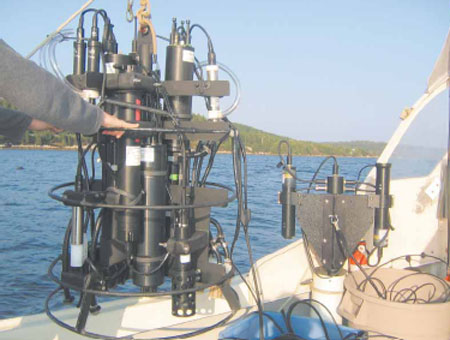
Monitoring arrays gather the data needed to develop the low cost prototypes.
It's in no one's best interests to have shellfish operations depleting phytoplankton food sources in bays off the Canadian coast, but it can be an expensive proposition to buy all the highly-sensitive monitoring equipment to assess the right amounts of biomass to match a particular area's natural resources.
"Optimization of yields depends on matching the stocking density of shellfish to the availability of food," said oceanography professor Dr. John Cullen, Chair of Environmental Observation Technology at Dalhousie University in Nova Scotia.
"Too many shellfish per acre will deplete the food resource and growth will be low; too few shellfish and harvests will be less than nature could support."
So doctoral student Diego Ibarra is working under Cullen on a research project to come up with cost-effective measuring systems which will be sufficiently accurate to help growers keep a handle on the most suitable levels of biomass for their different sites.
According to Cullen, as lead investigator on the project, much of the work is being done by Ibarra, who has indicated an interest in coming up with appropriately inexpensive devices for the industry, based on more sophisticated devices generated by Cullen and others from previous oceanographic studies on the areas around shellfish farms.

Diego Ibarra deploys monitoring array.
Some of that work with larger, higher-tech observation and monitoring systems is still continuing, in part to aid Ibarra in his research, said Cullen; and Dalhousie now has what Cullen refers to as "an ocean observatory" using a series of buoys in Ship Harbour, Nova Scotia.
The observatory consists of four buoys fitted with automated measuring devices to collect information on the oceanographic, meteorological and optical properties of the water, some of it being transmitted directly back to data banks at Dalhousie for storage and retrieval.
Cullen and Ibarra are particularly monitoring the clarity and colour of the upper few metres of the ocean in the bay directly around mussel rafts in the area.
Cullen said the work will allow researchers to make their own estimates of the concentrations of phytoplankton populations and of other water-borne substances - such as sediment in the immediate vicinity of shellfish cages, which will also enable project personnel to calculate the uptake of the microscopic phytoplankton by shellfish at the operations.
"It's basically a new, automated approach to obtain nearly-continuous recording of the properties of the water," said Cullen, adding that water samples are also taken to ground-truth the accuracy of their sensors and data.
"The instruments on the buoys give us very detailed measurements of the optical properties of the water, and we compare them with simultaneous findings from people going out and sampling the water," he said.
"We use these comparisons to come up with equations which will let others estimate the concentrations of materials in the water at their sites, using comparatively inexpensive light and clarity-monitoring instruments being developed by Ibarra," said Cullen.
Cullen said that the much larger and more high-tech instruments require comparatively large, moored buoys in the bay, but Ibarra has managed to devise prototypes for much smaller, less costly and less-detailed instruments which can be hung at different depths from much smaller buoys.
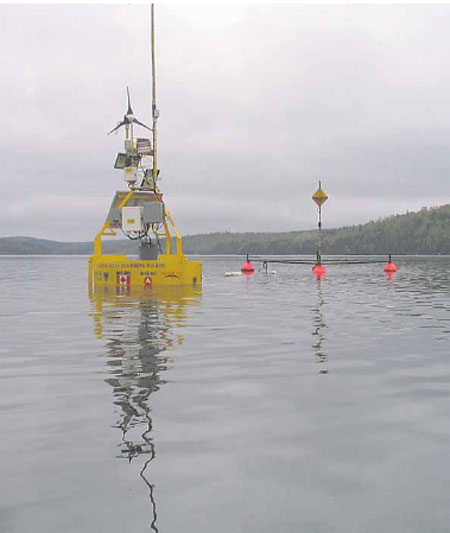
An "ocean observatory" has been created by using a series of buoys in Ship Harbour, Nova Scotia.
The two-year research project, which springs from studies dating back to 2000 is being conducted with the help of AquaPrime and the Satlantic Inc instrumentation company. The study is due for completion next spring, but is to be extended to both British Columbia and Spain as Ibarra works towards his doctoral degree in about two years' time.
Research team: John Cullen, Diego Ibarra and Penny Barnes, with partner Satlantic, Inc. For information contact John Cullen (Email: John.Cullen@Dal.CA). Submitted by AquaNet.
Jan.'05-Mar.'08
Controlling invasive tunicates in PEI
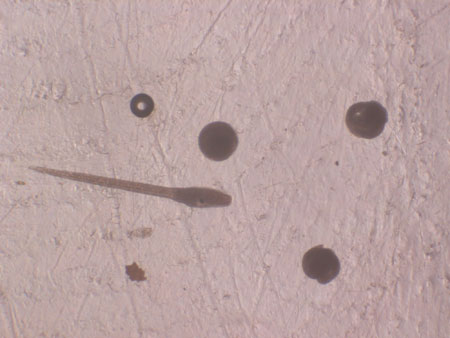
Eggs and larvae of the clubbed tunicate (Styela clava). These are released into processing effluents and could potentially be introduced into non-infested waters.
Several invasive tunicates have been introduced into Prince Edward Island waters during the last decade. These pests could have a devastating effect on the sustainability of the entire PEI mussel industry. Propagation of aquatic invasive species (AIS) generated by processing plants has not been well documented. The main risk attributed to processing is the movement of product (including hitchhikers) to the facility and subsequent release into receiving waters through effluent. There is an urgent need to understand the risk of dispersal of AIS through processing facilities to avoid any further spread. This study evaluates the risk of spreading tunicates associated with husbandry practices and environmental conditions within processing plants. Propagation pressure may vary considerably in relation to environmental, husbandry and infestation characteristics within these plants. The main focus of this research is to identifying processing stages that present a high risk of introduction and develop control strategies to minimize the potential for gamete and larvae release.
Research team: Daniel Bourque, Angeline LeBlanc, Gilles Miron, Thomas Landry. For information contact Daniel Bourque (Email: bourqued@dfo-mpo.gc.ca). Submitted by DFO (ACRDP).
Jun.'05-Mar.'08
Identifying Mussel Seed with Genetic Profiling
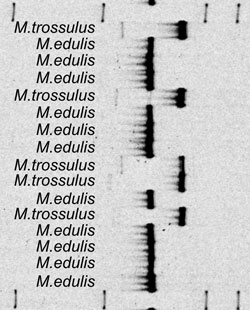
Mussel species identification gel image results for locus Me15/16.
One of the issues facing the mussel aquaculture industry in Nova Scotia is obtaining seed mussels of the correct species. Two mussel species are found in the region, Mytilus edulis and M. trossulus: the preferred culture species is M. edulis. These two species can be difficult to distinguish based on their morphology alone and to complicate the situation further, they are known to form hybrids.
Molecular biology tools, specifically protein (allozymes) and DNA based tests have been developed to distinguish the two species. Technical difficulties have been identified in using these developed assays, therefore in the first phase of this project (April 2005-March 2006) we evaluated the DNA based tests, identified reliable assays and improved these tests so they can be used with more samples for less cost. In the second phase of this project, in collaboration with the Nova Scotia Department of Agriculture and Fisheries, we are using these assays to look at the species composition of seed sized mussels collected around Nova Scotia, in order to identify good regions for seed collection.
Research team : Lorraine Hamilton, Koren Spence, Benedikte Vercaemer, Andrew Bagnall (NSDAF). For information contact Lorraine Hamilton (Email: HamiltonL@mar.dfo-mpo.gc.ca). Submitted by DFO (ACRDP).
Jun.'05-Mar.'08
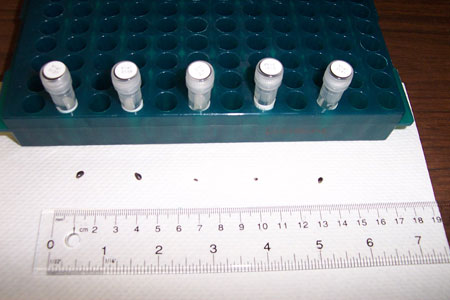
Species identification using DNA techniques can be done on mussels that are quite small, just a couple of millimeters
Productivity, thresholds and networking in bivalve aquaculture
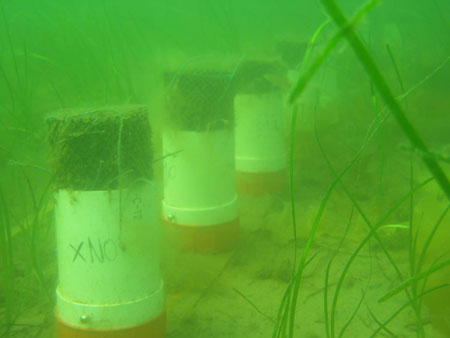
An array of experimental "mesocosms" used to test the influence of different levels of organic enrichment from mussel aquaculture on benthic communities. The cages on top of the cylinders contain different numbers of mussels.
Much work has shown that bivalve culture may influence the structure of benthic communities. However, recent work shows that bivalve culture may also increase local secondary productivity, at times to levels greater than that recorded in adjacent "high productivity" environments. How general is this observation? Also, these and other effects are likely a function of the intensity of bivalve farming being done in an area. What density of bivalves can an area hold without modifying benthic communities? What do other researchers think of these ideas and how can research on these subjects be better coordinated? The current project addresses these points.
First, work is being done to test the hypothesis that benthic productivity in mussel culture sites is greater than that in adjacent sandy and eelgrass habitats. Second, we modified organic (mussel faeces) loading rates to develop dose-response curves to determine how different stocking densities influence benthic infaunal communities. Third, we held a special session with a keynote speaker on aquaculture-environment interactions at the 35th Benthic Ecology Meeting in Quebec City in March 2005. Over 50 people from a dozen countries participated in the session. In addition, future collaborations to further understand the role of aquaculture in the environment are planned.
Research Team: Chris McKindsey, Philippe Archambault, Myriam Callier, Brianna Clynick. For information contact Chris McKindsey (Email: mckindseyc@dfo-mpo.gc.ca). Submitted by DFO (ACRDP) and RAQ.
Nov. '05-Mar. '08.
In search of quality mussel seed in Newfoundland

Environmental data collection with YSI Sonde profiler deployed by Sean Macneill Badger Bay Mussel Farms and Sharon Kenny DFO.
Increased mussel seed availability has become the number one industry priority for the expansion and continued development of the Newfoundland mussel aquaculture industry. Fisheries and Oceans Canada and the Newfoundland Aquaculture Industry Association in partnership with the Provincial Department of Fisheries and Aquaculture, Memorial University, National Research Council and the Canadian Centre for Fisheries Innovation are working together on a five year project to locate potential sources of mussel seed in Newfoundland. Bays and regions which had not been previously used for this purpose are being examined as possible sites.
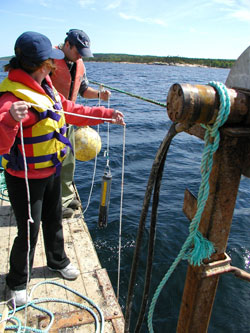
Riverboat flotation for acoustic Doppler profiler collecting current data at mussel aquaculture site with DFO Aquaculture technician Sharon Kenny.
Seed collector arrays were designed, constructed and deployed at potential and current aquaculture sites in Newfoundland. Time series studies at two aquaculture sites are ongoing and examine the differences in collection strategies for the two main mussel species of interest (Mytilus edulis andMytilus trossulus). The study also includes comparing information on how the two different mussel species grow and survive in different bays if they are transported to new sites. Genetic comparisons of the seed from potential sites are also being conducted. Information on the interaction of biological and physical oceanography, particularly current strength and direction, on mussel collection and survival in a cold marine environment is vital to the sustainability and expansion of aquaculture in Atlantic Canada.
Research team: Cynthia McKenzie (DFO), Lynette Carey (NAIA), Cyr Couturier (MUN), Dave Innes (MUN), Ray Thompson (MUN), Derek Mouland (NLDFA), Chris Brown (NRC), Marc Kielley (CCFI). For information contact Cynthia McKenzie (Email: mckenziec@dfo-mpo.gc.ca). Submitted by DFO (ACRDP). Jul.'06-Sept.'07
Optimizing geoduck out-planting and minimizing environmental impacts
This research examines the possible effects of intertidal and subtidal aquaculture of juvenile geoduck clams (Panopea abrupta) and the potential effects of harvesting these clams on the benthic environment. Possible influences being examined include changes in sediment biogeochemistry (i.e. sediment grain size, percent organics, total organic carbon, total nitrogen, sulphide concentration, oxidation-reduction potential) and infaunal species diversity. Research is also examining the efficacy of various predator protection technologies. Intertidal research is utilizing PVC tube technology for predator protection and is examining the effects of tube diameter, tube length, and mesh size of screen covering the tubes on clam survival and growth. Subtidal research is examining growth and survival of juvenile clams that are being protected from predators with various biodegradable materials. Another component of the research project is focusing on the development of high-quality broodstock for hatchery production.
Research team: Chris Pearce, Sean Williams, Laurie Keddy, John Blackburn, Yu Xin An, Debbie Paltzat, Robert Marshall. For information contact Chris Pearce (Email: PearceC@pac.dfo-mpo.gc.ca). Submitted by DFO (ACRDP).
Stressing out the Pacific oyster
The main goals of this research are to determine the stress response (using multiple stress biomarkers) of Pacific oysters (Crassostrea gigas) exposed to high temperature and harmful algae in laboratory conditions, as well as to establish the environmental conditions eliciting a stress response in oysters at a farm site. These are necessary to be able to predict and avoid the occurrence of irreversible stressors, leading to large-scale mortalities of BC cultured shellfish. The first objective is to test and calibrate, in the laboratory, existing stress indicator techniques [i.e. heat-shock protein (HSP) 70 and neutral red dye retention (NRR)] in Pacific oysters using heat-shock treatment as a model stressor. The second objective is to test and compare, in the laboratory, other stress indicators (i.e. metalloproteases and ubiquitin conjugates) for their utility in assessing oyster stress levels. The third objective is to investigate the effect of temperature and harmful algae on stress bio-indicators and survivorship of cultured Pacific oysters under laboratory conditions. The fourth objective is to determine, during an entire annual cycle, the in situ levels of these multiple stress biomarkers (HSP 70, NRR, metalloproteases and ubiquitin conjugates) in Pacific oysters at a farm site on the east coast of Vancouver Island, and the environmental conditions at the site. We aim to correlate various environmental conditions with times of high stress in the oysters.
Research team: Chris Pearce (DFO), Maria Maldonado (UBC), David Cassis (UBC), Abayomi Alabi (CSR), Neil Ross (NRC), Nadene Ebell (Odyssey Shellfi sh), David McCallum (BCSGA). For information contact Chris Pearce, (E-mail: PearceC@pac.dfo-mpo.gc.ca). Submitted by DFO (ACRDP).
Jul.'06-Jul.'08
Mussel aquaculture and ecosystem productivity
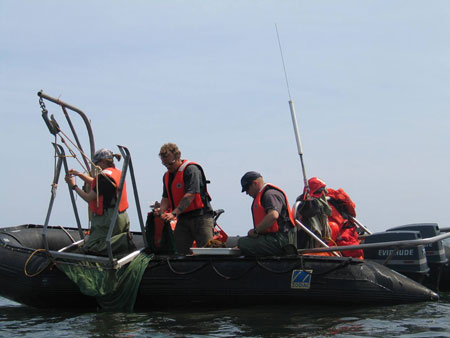
Field work to examine the influence of mussel aquaculture on the productivity of benthic communities. Here a small beam trawl is used to capture fish and large invertebrates.
Most work that examines the influence of bivalve culture on the benthic environment to date has focused on changes in the structure of communities living in the sediments (infaunal communities). Little work has examined the influence of bivalve culture on benthic productivity or on the distribution and productivity of larger organisms, such as crabs and lobster, which may take advantage of an abundance of food and structure provided by bivalve culture. This project examines 1) the influence of mussel culture on infaunal productivity and 2) the distribution and productivity of large organisms. This work is being done on the Magdalen Islands and Prince Edward Island.
Initial analyses show that although infaunal communities differ between aquaculture and non-aquaculture sites, productivity does not. Further, when the productivity of infauna associated with the mussel lines themselves is included in the analyses, "benthic" infaunal productivity is greater in areas with mussel culture than in areas without it. The abundance of large organisms, especially lobster, crabs, starfish, and other predators is much greater within mussel culture sites than in areas without mussel culture. In contrast, the growth rates of these large organisms do not differ between areas within and outside of culture sites.
Research team: Chris McKindsey, Philippe Archambault, Andrea Weise, Paul Robichaud, Lisa Robichaud, Olivier D'Amours, Brianna Clynick, Frédéric Hartog, Chantale Langevin, Catherine Godbout, Guglielmo Tita, Thomas Landry. For information contact Chris McKindsey (Email: mckindseyc@dfo-mpo.gc.ca). Submitted by AquaNet, DFO(ACRDP), SODIM, RAQ.
Apr.'04-Mar.'07
Growing Pacific geoduck clams

Juvenile geoduck clams.
Research related to geoduck clam (Panopea abrupta) aquaculture is being undertaken and touches on several aspects of the culture cycle, ranging from broodstock conditioning to larval rearing, juvenile rearing, and outplanting. Broodstock conditioning experiments will focus on the effect of temperature on gonad development and how this translates into larval success (in terms of growth, survival, and condition). Optimal nursery conditions for post-set clams will be examined by monitoring growth and survivorship under various treatments of temperature, feed type, water exchange rate, stocking density, and substrate type. The potential of a low cost, raft based nursery system for geoduck clam seed will also be examined. This experiment will determine the effect of various gear types, culture depths, and stocking densities on juvenile clam growth and survival. Burrowing behaviour experiments will be conducted to help determine the appropriate season, animal size, and substrate type for outplanting. Through this series of experiments we hope to improve the understanding of the basic biology of these animals as it relates to commercial aquaculture production.
Research team: Chris Pearce, Robert Marshall. For information contact Chris Pearce (E-mail: PearceC@pac.dfo-mpo.gc.ca). Submitted by DFO (ACRDP).
Apr.'05-Mar.'10
Sources and management of cadmium in Pacific Oysters
Pacific oysters (Crassostrea gigas) cultured in British Columbia have occasionally had levels of cadmium (Cd) in their tissues that have been higher than acceptable limits put in place by some international markets. This project's main goals were to: (1) investigate the potential pathways of cadmium accumulation in cultured oysters and (2) identify management tools/practices that may help local shellfish farmers to avoid relatively high cadmium levels in their products. Two sites on Vancouver Island (one on both the east and west coasts of the island) were monitored for one year for cadmium levels in oysters and several environmental parameters (including water temperature, salinity, particulate Cd levels, dissolved Cd levels, and phytoplankton species).
Field results showed that cadmium in oysters followed a seasonal trend, with levels lowest in the spring and summer months. Temperature had the greatest negative effect on cadmium levels in oysters and dissolved cadmium was identified as the primary pathway into the oysters. Phytoplankton were not a vector of cadmium entry into oysters, but rather helped the oysters to depurate the cadmium. Lab depuration experiments were conducted using cadmium-free water and food, but no substantial reduction in cadmium levels was observed after 21 days. Management tools such as monitoring for a certain phytoplankton species or growing oysters at different depths were inconsequential for reducing cadmium concentrations in oysters. The best option for farmers would be to harvest oysters in periods of warmer temperatures, high phytoplankton abundance, and low dissolved cadmium levels.
Research team: Chris Pearce (DFO), Maria Maldonado (UBC), Kristin Orians (UBC), David Cassis (UBC), Anka Lekhi (UBC), Nadene Ebell (Odyssey Shellfi sh), Leah Walberg. For information contact Chris Pearce (E-mail: PearceC@pac.dfo-mpo.gc.ca). Submitted by DFO (ACRDP).
Aug.'04-Jul'05
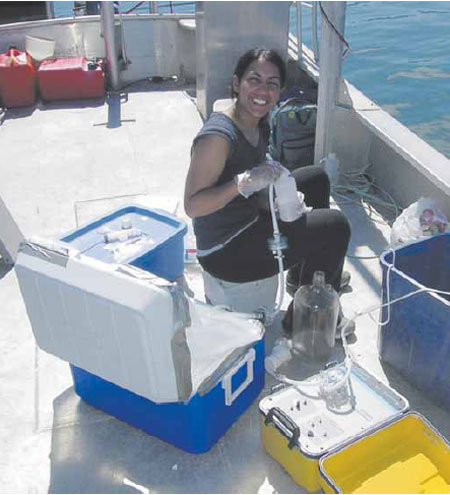
Cockle broodstock development in British Columbia

Researchers hope to determine the factors that influence cockle broodstock maturation and develop standard operating procedures to ensure consistent production of high quality gametes.
There is significant interest in pursuing commercial aquaculture of the indigenous cockle (Clinocardium nuttalli) in British Columbia due to its ability to exist in diverse habitats from sand/gravel to mud and within both the intertidal and shallow subtidal regions. This species is also valued as a traditional food among local First Nations.
A consistent supply of high quality seed is a prerequisite for a successful cockle aquaculture industry and the development of broodstock is fundamental to ensuring the availability of consistent high quality seed. To establish the optimal conditioning methods for broodstock cockles, the effects of biotic/abiotic factors (e.g. temperature, food type, food concentration, etc.) on gonad maturation need to be studied. Before research into commercial cockle production systems can begin, it is necessary to understand the factors influencing broodstock maturation and to develop standard operating procedures to ensure the consistent production of high quality gametes from broodstock.
To this end, our objectives for the project are as follows: (1) To determine the optimal feeding rates and feed items for conditioning cockle broodstock; (2) To evaluate the influence of temperature on metabolic rate of adult cockles at temperatures between 5 and 30oC; (3) To establish the Biological Zero Point and the Effective Accumulative Temperatures for gonad maturation; (4) To establish the optimal physical requirements to achieve optimal fertilization rates; and (5) To provide cockle seed to partner companies for research into commercial seeding strategies for maximizing production. Future research proposals are planned to support this work.
Research team: Abayomi Alabi (CSR), Chris Pearce (DFO), Wenshan Liu (CSR). For information contact Abayomi Alabi (E-mail: AlabiA@mala.bc.ca). Submitted by DFO (ACRDP).
Nov. '05-Mar. '07
Factors controlling invasion success of tunicates in British Columbia
Currently, there are at least four species of tunicates in British Columbia which are non-native and potentially invasive: the solitary tunicate Styela clava (club tunicate) and the colonial tunicates Botrylloides violaceus (violet tunicate), Botryllus schlosseri (golden star tunicate, and Didemnum sp. Recent monitoring surveys have detected some of these tunicate species at a variety of shellfish culture leases and marinas around British Columbia. However, it appears that they have not had the same impact on this coast as in Prince Edward Island and Nova Scotia, raising questions about the factors controlling invasion success and establishment.
One area of research aimed at resolving these questions relates to basic tunicate biology and ecology. This project will examine how survivorship, growth, and reproduction of these tunicates are affected by changes in environmental conditions (e.g. temperature, salinity, and desiccation), predation intensity, and physical/chemical treatments (e.g. sodium hypochlorite, acetic acid, freshwater). The results of these experiments should allow us to assess the ability of these tunicates to invade new habitats and the threat that they may pose to other benthic invertebrates within the ecosystem. The research should also enable development of mitigation strategies to prevent further spread of these non-indigenous species and undue economic hardship to the shellfish culture industry of British Columbia.
Research team: Chris Pearce, Thomas Therriault, Anna Epelbaum. For information contact Chris Pearce (E-mail: PearceC@pac.dfo-mpo.gc.ca). Submitted by DFO (ACRDP).
Aug. '06-Aug. '08
Researchers monitor domoic acid poisoning in Quebec scallops
Domoic acid (DA) is a potent neurotoxin produced by several species of planktonic diatoms belonging to the genus Pseudo-nitzschia. Toxic blooms of Pseudo-nitzschia can cause shellfish to become poisonous and unfit for human consumption. In scallops, domoic acid is not found in the adductor muscle, but is present in other tissues, thus preventing the harvesting and sale of whole scallops.
For the past several years, two scallop aquaculture sites on Quebec's lower north shore have been afflicted with persistent domoic acid contamination that has prevented harvesting for months at a time. To confirm that blooms of Pseudo-nitzschia spp. are responsible for the contamination, a weekly monitoring program has been established in which samples are collected for taxonomic analysis, including imaging by electron microscopy, to identify the presence of Pseudo-nitzschia and determine the period of the year in which domoic acid contamination takes place. The ultimate goal is to design a mitigation strategy to minimize the exposure of the scallops to the toxic blooms by temporarily sinking the scallop lines, or moving them to an uncontaminated location.
Research Team: Michael Scarratt, Sonia Michaud, Stephen Bates, Yannick Goaziou, Jean Côté, Isabel Caldéron, Maurice Levasseur. For information contact Michael Scarratt (Email: ScarrattM@dfo-mpo.gc.ca). Submitted by DFO (ACRDP).
Apr.'06 - ongoing
Monitoring invasive species in Nova Scotian waters
Invasive species of tunicates, also known as ascidians or "sea squirts", pose a serious threat to the marine ecosystem. Once established, invasive tunicate populations are expensive and difficult to control, especially in waters with aquaculture and boating operations where attachment structures are present and tunicates may be spread through inadvertent transportation. In the Maritimes, four species of tunicates have caused problems for the shellfish aquaculture industry: Ciona intestinalis, Botryllus schlosseri and Botrylloides violaceaus (PEI and NS) and Styela clava (PEI). A fifth invasive species of concern on the eastern US coast, Didemnum sp., has not yet been observed in Atlantic Canada.
An Aquatic Invasive Species (AIS) monitoring project was initiated by DFO in 2006 to determine the distribution of these five species in Nova Scotian waters. Tunicate collectors were placed at public wharves, marinas and aquaculture leases along the coast of Nova Scotia and the Bay of Fundy (New Brunswick). Three targeted monitoring sites were established in areas with tunicate infestations. Public awareness and community participation are promoted by the distribution of brochures and posters and the establishment of an invasive species reporting e-mail and phone line. A better understanding of the distribution and biology of tunicates will facilitate the development of an effective management strategy.
Research team: Bénédikte Vercaemer, Dawn Sephton, Jean-Marc Nicholas, Jennifer Martin, Murielle LeGresley, Andrew Bagnall. For information contact Dawn Sephton (Email: sephtond@mar.dfo-mpo.gc.ca). Submitted by DFO (ACRDP).
Apr. '06-Mar. '08
Database to compile info on pathogens in Quebec shellfish
The objective of the project is to compile a historical database on the prevalence and intensity of the parasites present in the various shellfish populations at commercial and experimental culture facilities in maritime Quebec. This gives us a temporal and spatial assessment of the distribution of the various pathogens that can have a major impact on economically important shellfish species. With the increase in shellfish culture over the past decade, new pathogens have emerged at culture facilities with the potential to cause significant production losses. The results of the analyses will enable us to monitor changes in the various diseases and to minimize the impact of the proliferation of pathogens through appropriate management methods. In high densities, some otherwise harmless parasites can become very harmful, and intensive culture operations can promote the proliferation of pathogens. For this reason, the project includes a component comparing the parasites present in the mussel populations on both natural and farmed beds.
Research team: Sonia Belvin, Réjean Tremblay, Benoit Thomas, Charley Cyr, Carl R. Uhland. For information contact Sonia Belvin (Email: sonia.belvin@partenaires.mapaq.gouv.qc.ca). Submitted by ACRDP and RAQ.
Mar. '04-Mar. '07.
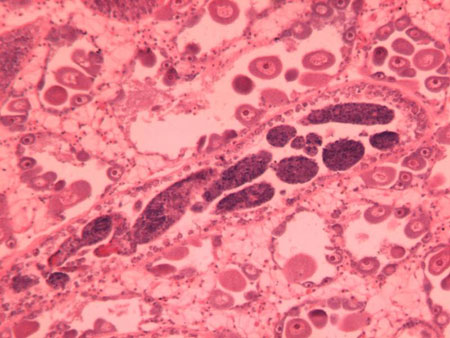
Prosorhynchus squamatus in the mussel.

Hemocytic neoplasia in the mussel.
Developing MSX resistant oyster broodstock in the Bras d'Or Lakes
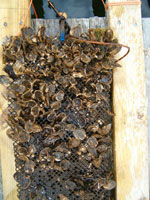
Breeding for MSX resistance/tolerance is seen by the different stakeholders as a long term strategy for recovery of the Bras d'Or oyster in Cape Breton, Nova Scotia.
The American oyster (Crassostrea virginica) is an economically, ecologically and culturally important species in Cape Breton, Nova Scotia, but populations have been in decline due to over- fishing, degradation of habitats and by the appearance of the MSX parasite (Haplosporidium nelsoni) in the Bras d'Or Lakes (Pitupa'q) in 2002. Breeding for disease resistance/tolerance is seen by the different stakeholders (DFO, EFWC, oysters growers, Mi'kmaq elders) as a long term strategy for the recovery of the Bras d'Or oyster. After 3 years of disease challenges in the Bras d'Or Lakes, the timing for the initiation of a selection program is opportune. Oysters that are surviving in the MSX affected areas are exhibiting a level of tolerance and should be considered prime broodstock for initiating a MSX resistance breeding program.
The initiation of a breeding program for MSX resistance in the Bras d'Or Lakes oyster had the following objectives:
- initiate a rotational breeding plan at the Unama'ki Institute of Natural Resources, Eskasoni, with oysters from specific sites within the Bras d'Or Lakes,
- test the progenies in field sites,
- make recommendations for an expansion/continuation of the breeding program and for future restoration programs.
During the course of the project, it became evident that the surviving oysters collected from MSX infected sites were not in optimal condition. The direct and/or indirect effects of the MSX parasite on gamete production and spawning of the oyster are not clear, but in general, MSX infection impedes on the abilities of an adult oyster to properly reproduce.
Temperature and salinity influence the activity the MSX parasite. Temperatures below 5oC or above 20oC have been reported to control infection. Previous research has also shown that H. nelsoni is inactive or absent at low salinity (10 ppt or lower) and low salinity immersions of oysters have been used as a control measure in Delaware Bay and Chesapeake Bay. A problem with this approach is that oyster gamete production is retarded at salinities below 5 ppt.
The continuation of this project will determine the time-temperature-salinity combinations needed for appropriate gamete production and spawning in MSX infected broodstock at the Unama'ki Institute of Natural Resources, Eskasoni. This is critical to (1) ensure the success on the on-going breeding program for resistance to MSX initiated in Eskasoni for the Bras d'Or Lakes oysters, and (2) refi ne timing and zoning of oyster management activities within the Lakes.
Research team: Bénédikte Vercaemer, Barry MacDonald, Koren Spence, Shawn Roach, Mary Stephenson, Charlie Dennis, Shelley Denny, Allison McIsaac, Philip Drinnan, Robert Denny, Shauna Gould, Lewis Clancey . For information contact Bénédikte Vercaemer (Email: VercaemerB@mar.dfo-mpo.gc.ca). Submitted by DFO (ACRDP).
Jun. '06-Dec. '07
DNA-based family identification for Pacific scallops in British Columbia
Selective breeding has only recently been applied to shellfish aquaculture because it is difficult to determine pedigrees when parents produce large quantities of gametes that mix haphazardly in water. Until now, selective breeding has required raising the offspring of each family in separate rearing tanks until they can be individually marked. Aside from the added cost, separate rearing tanks make it impossible to determine how much of the variation in the desirable trait, in this case meat yield, is due to differences in the tanks.
Recent advances in DNA technology make it possible to match parents to offspring, enabling the rearing of multiple families and strains under common or randomly assigned conditions. By rearing strains together, we reduce environmental differences so we can accurately estimate heritability and, thus, potential for selective breeding. In this project, we will develop molecular techniques using microsatellite loci to match parents with offspring and determine whether or not there is a sufficiently broad genetic base in the domesticated strain to support a sophisticated breeding program while minimizing inbreeding depression. We will also undertake preliminary research to locate molecular markers that are associated with higher meat yield in Pacific scallops.
Research team: R. Withler (DFO), and R. St. Clair (Island Scallops). For information contact R. Withler (Email: withlerr@pac.dfo-mpo.gc.ca). Project Submitted by DFO (ACRDP).
Sept.'06-May'08
Rapid Response for treatment of the Violet tunicate
The violet tunicate (Botrylloides violaceus) and golden star tunicate (Botryllus schlosseri), unlike the solitary clubbed tunicate (Styela clava), are colonial and thus considered a greater fouling challenge for the mussel industry. They not only reproduce sexually spreading larvae through the water column but also can bud or fragment producing new colonies which will drift and easily spread the tunicates, infesting adjacent and distant leases, depending on environmental conditions and/or anthropogenic effects. Of particular concern is the fact that the violet tunicate can encase and smother the crop. Tunicates are having significant impacts on mussel seed collection, the cost of operating mussel farms and processing the crop.
At the present time, there are no established rapid response measures for these types of infestations, either from a treatment perspective or from a removal (eradication) perspective. The mussel industry, however, is willing to attempt to reduce the impact and spread of tunicate infestation through the removal of a significant amount of the biomass of the violet tunicate by treating all infested mussels leases, including lease gear and mussel crop.
The goal of this project will be to treat all infested leases in Cardigan River in order to reduce the biomass of violet tunicates on mussel socks and culture gear. The main objective of the study will be to assess the effect of this rapid response by evaluating and comparing the recruitment levels in Cardigan Bay utilizing Savage Harbour, as a control bay. A secondary objective will be to monitor the effect of treatment on the infestation levels both on the mussel socks and the bottom under and around the infested leases.
Research team: Neil McNair, Daniel Bourque, Thomas Landry. For information contact Thomas Landry (Email: LandryT@dfo-mpo.gc.ca). Submitted by DFO (ACRDP).
Nov. '05-Sept. '06
Determining the origin of scallop spat used in culture and restocking
The sea scallop (Placopecten magellanicus) is a very important species for both fisheries and aquaculture. Bottom seeding in the Magdalen Islands and suspended culture are two approaches adopted by the industry to improve yields. However, both types of operation depend on spat collection in the natural environment, which, in the Magdalen Islands, takes place in a sector different from the one being restocked. The main objective of the project was to determine the origin of the spat by comparing their genetic and metabolic characteristics with those of individuals from different beds.
More than 1,500 adult individuals from 18 beds in the Magdalen Islands, the Gaspé Peninsula, the southern Gulf and the Lower North Shore as well as spat and juveniles from the Fond du Sud-Ouest were sampled. The study was not able to identify the origin of the spat because of the absence of genetic or metabolic signatures specific to this site. However, the study did provide basic data on the genetic characteristics of the sea scallop in the Gulf of St. Lawrence that could be used as a reference point during subsequent studies concerning, for example, the effects of environmental variations or aquaculture. There is little genetic differentiation among sea scallops from different regions of the Gulf of St. Lawrence, probably because larval dispersion is significant. The only genetic differences detected are limited to the sites on the Lower North Shore that differ from each other and also from the other sites examined in the study. The genetic differences observed among Lower North Shore sites may be linked to small populations living in relatively closed bays.
Research team: Jean-Marie Sévigny, Réjean Tremblay, Éric Parent, Marc-André Roy, Michel Giguère, Georges Cliche. For information contact Jean-Marie Sévigny (Email: SevignyJM@dfo-mpo.gc.ca). Submitted by DFO (ACRDP), ISMER and RAQ.
Apr. '02-Mar. '06
Genetic tools for selection of crayfish broodstock
Freshwater crayfish culture is carried out primarily in China, the U.S, Europe and Australia, producing a high quality aquaculture product that is in high demand. Fewer than a dozen species are cultured, including the Signal crayfish (Pacifasticus leniusculus), that is native to British Columbia. Very little is known of the genetic diversity encompassed in wild or cultured populations of most crayfish species, and little genetic improvement (selective breeding) has been carried out in cultured broodstocks.
Further development of the Signal crayfish as a commercial species requires identification of important components of biodiversity within the species and the subsequent implementation of a broodstock program that will allow continued genetic evaluation and selection for traits such as growth and disease resistance. We will isolate microsatellite loci from Signal crayfish from a genomic library using standard methodologies. We expect to obtain at least eight loci that are polymorphic in P. leniusculus and use them to produce multilocus genotypes on individual crayfish collected from several locations in the wild. The loci will also be used to confirm the success of controlled matings (one male with one female) within a hatchery facility.
Research team: R. Withler (DFO), and B. Swift (Brumar Consultants Ltd.). For information contact R. Withler (Email: withlerr@pac.dfo-mpo.gc.ca). Submitted by DFO (ACRDP).
Sept. '06-Jun. '07
How water temperature effects oyster feeding rates
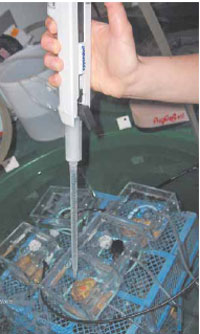
Micro-algae being introduced into bivalve feeding chambers held at 0°C.
Domoic acid (DA) is a neurotoxin produced by certain diatom species that are a source of food for filter-feeding mollusks. Although DA does not harm mollusks, it can cause Amnesic Shellfish Poisoning (ASP) in humans. In the spring of 2002, high concentrations of a cold-water diatom,Pseudo-nitzschia seriata, resulted in unacceptable levels of DA (greater than 20 µg DA/g) in mussels. This distinctive outbreak occurred in spring instead of Autumn and was detected not only in PEI, but also in NB, Quebec and NS. The unexpected results were the basis for a widespread and lengthy harvest closure directed at most shellfish species, including the American oyster.
The generalized nature of the closure was questioned, given evidence that the update and depuration of biotoxins can differ markedly from one shellfish species to another. The objective of this project will test two hypothesis: 1) Cultivated oysters and mussels begin feeding at a similar temperature in the spring; 2) In oysters exposed to low temperatures, feeding rates (as defined by the amount of organic matter absorbed by 1.0 g of tissue over a 24h period) is uncorrelated to animal size. The results may provide a scientific basis for developing the approach for managing shellfish closures by species in Atlantic Canada. This concept aims at optimizing both harvest opportunities and DA monitoring efforts.
Research Team: Fabrice Pernet, Réjean Tremblay, Stephen Bates, Angeline LeBlanc and Thomas Landry. For information contact Luc Comeau (Email: ComeauL@dfo-mpo.gc.ca). Submitted by DFO (ACRDP).
Project to assess localized feed distribution at East Coast oyster farm
Seed is being deployed on shellfish leases with little consideration to localized inequalities in growing conditions. The concentration of food particles may be lower, perhaps frequently, in a given area of a lease compared to other areas. Factors such as currents and water temperature may stress animals to a point of reducing the uptake of available food resources. Shellfish growers could possibly take advantage of localized patterns with the commercial objective of shortening the production cycle. This strategy would be a first step in site management with the objective of optimizing yields. In order to attain that level of production at their site, leaseholders need to assess both the magnitude and persistence of localized features within their leases.
The primary objective of this project is to determine if the current stocking density of cultivated oysters (2,000 oyster bags per hectare) can deplete food resources within the farm at some point during spring, summer and fall.
Research Team: Rémi Sonier, Fabrice Pernet and Thomas Landry. For information contact Luc Comeau (Email: ComeauL@dfo-mpo.gc.ca). Submitted by DFO (ACRDP).
Feb.'06-May'08
New Brunswick researchers test oyster gear for bird-deterring effectiveness
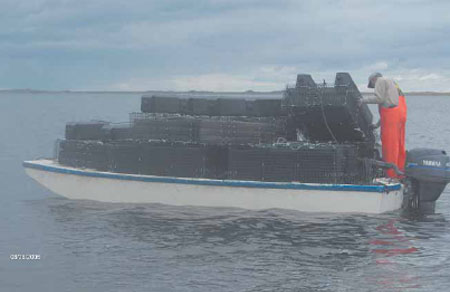
Deploying experimental floating oyster gear in New Brunswick.
In New Brunswick, American oyster (Crassostrea virginica) aquaculture is mainly carried out using floating Vexar® bags, keeping the filter-feeders in relatively warm and phytoplankton-rich surface waters. However, routine sampling in September 2004, indicated deposition of bird fecal matter on a number of floating bags containing market-size oysters. Some oyster samples exceeded the standard for fecal coliforms, nearly causing total shut down of all oyster production and marketing activities in Eastern New Brunswick, involving some 150 aquaculture sites.
Due to the risk of fecal coliform contamination, suspended culture gear of all types can no longer be used for the mandatory depuration procedure. This lead to a new labour intensive husbandry step, thus the majority of the industry is currently growing oysters using floating gear which must be converted into non-floating gear a few weeks prior to the marketing of oysters.
The industry is considering a low-cost modification which would convert the floating gear into anti-roosting platforms. The industry is proposing two research objectives: (1) evaluate the bird-deterring efficiency of four experimental floating gear types, and 2) evaluate whether the birds will use the deterring gear when no other option is made available to them.
Research team: Fabrice Pernet, Roland Chiasson and Eve-Julie Arsenault. For information contact Luc Comeau (Email: ComeauL@dfo-mpo.gc.ca). Submitted by DFO (ACRDP).
Aug.'06-Mar.'08
Minimizing fouling and maximizing production in floating bag oyster culture
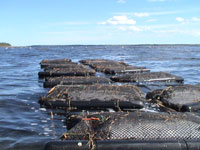
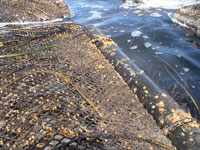
The overall aim of the project is to improve productivity and minimize environmental impacts. Researchers will investigate the relationship between bag turning frequency, fouling levels, organic sedimentation rates and oyster quality.
Aquaculture of the American oyster (Crassostrea virginica) in Atlantic Canada has grown significantly in the past decade, largely as a result of the development of suspended bag culture. The recent DFO National Advisory Process on the environmental effects of shellfish aquaculture elucidated many of the important knowledge gaps concerning suspended oysters and their potential effects on the environment. One perceived source of organic matter which may contribute to an environmental impact is the accumulation of fouling organisms on the equipment. If not managed appropriately, this fouling assemblage may contribute substantially to the level of biodeposition, both in terms of faecal matter as well as fall-off during maintenance and harvesting.
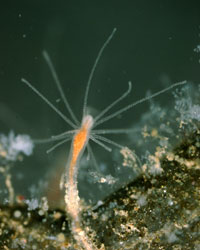
Typically, shellfish growers develop their husbandry methods on an independent basis through trial and error while endeavoring to optimize the productivity of their leases. The aim of this project is to increase the state of knowledge with regard to the farm management of floating bags in order to improve productivity and minimize environmental impacts. The overall objective is to investigate the relationship between bag turning frequency, fouling levels, organic sedimentation rates and oyster quality.
Research Team: André Mallet, Claire Carver, Simon Courtenay, Matthew Hardy. For information contact Matthew Hardy (Email: HardyMa@dfo-mpo.gc.ca). Submitted by DFO (ACRDP).
Jun. '06-Mar. '07
Researchers test bouncing buckets for remote setting of American oyster

Introducing oyster larvae into the bouncing bucket.
The culture of the American oyster (Crassostrea virginica) is dependent upon the settlement of wild larvae onto spat collectors and the subsequent transfer of these spats to grow out sites. However, this seeding approach is vulnerable not only to broodstock declines, but also to regulatory transfer restrictions, which can happen unexpectedly due to health issues (e.g. MSX) or the spread of invasive species (e.g. tunicates).
Remote setting of Pacific oysters (Crassostrea gigas) on the western coast (Canada and USA) has been researched extensively since the 1970s, and is currently applied at commercial-scales. The American oyster, on the other, has received considerably less attention. The natural spatfall at this northernmost range of the American oyster occurs in mid-summer, leaving little time for spat growth prior to the onset of winter. By remotely setting the larvae in early spring, the spat grow-out period can be considerably extended and larger seed oysters can be obtained by the fall of the same year.
We propose to quantify the setting rates of oyster pediveligers in field bouncing buckets. We will compare an innovative remote setting approach (field bouncing bucket) with a more conventional remote setting approach (controlled environment). The goal of the nursery component is to demonstrate that the newly settled spat contained in the experimental bouncing buckets can grow into large seeds by the fall of the same year.
Research team: Rémi Sonier, Fabrice Pernet and Thomas Landry. For information contact Luc Comeau (Email: ComeauL@dfo-mpo.gc.ca). Submitted by DFO(ACRDP).
Mar.'06-Mar.'07
Development of Optimal Seeding Techniques for the Culture of Softshell Clam
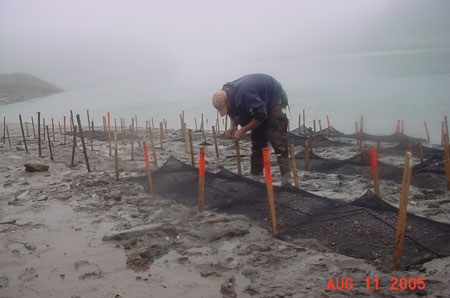
Researchers also hope to determine if disease is prevalent in the existing natural population and estimate the potential impact it may have as a component of culture techniques.
Various techniques have been developed to enhance wild populations of Mya arenaria through cultivation. The impacts of predation, timing of planting of juvenile seed, size of seed, substrate type, density and diseases such as haemic neoplasia, have been found to be significant factors in the survival success of juvenile M. arenaria.
The Southwestern New Brunswick Clam Resource Committee (CRC) has acquired a R&D occupational permit in Lepreau Harbour, New Brunswick where a decline in soft shell clam abundance has been observed over the past 15 years. Eastern Charlotte Waterways Inc. (ECW) chairs the CRC and is currently in the second year of establishing techniques for the culture and enhancement of softshell clam.
The objectives of this study are:
- to determine optimal conditions (size, substrate type and manipulation and density) for planting 300,000 hatchery spat currently over-wintering in cages moored at the St. Andrews Biological Station lease site.
- to determine if disease is prevalent in the existing natural population and estimate the potential impact it may have as a critical component of implementation of culture techniques.
Research team: Susan Farquarson (ECW), Nick Vance (ECW), Shawn Robinson (DFO), Mary Stephenson (DFO). For information contact Shawn Robinson (Email: RobinsonSM@mar.dfo-mpo.gc.ca). Submitted by DFO (ACRDP).
Study to develop and evaluate mussel seed quality standards
The main objective of this study is to develop and assess seed quality criteria based on physiological and pathological health, to assist the mussel industry in reducing the risk of costly high mortalities throughout the growout phase, and more specifically during the pre-sale period that is commonly associated with high environmental (increasing temperatures) and physiological (reproduction) stresses. A secondary objective will be to examine the economical and ecological benefits of new culling techniques to maintain or increase seed quality, in order to optimize the feasibility of mussel seed production and culture in P.E.I. and N.B. while improving the environment interaction of this industry.
In keeping with all of the above information, the overall rational of this project is to develop the tools and scientific capacity needed to optimize and sustain mussel production in P.E.I. and N.B. This project will also provide the basis for a long-term data gathering and analysis system that could be funded by the industry on a national application, similar to other agri-food industry such as the seed classification program of the potato industry. The expertise developed from this project will provide a basis for further research on shellfish farm management.
Research team: Réjean Tremblay, Nellie Gagné, Luc Comeau, Jeffrey Davidson, Mary Stephenson, Thomas Landry. For information contact Thomas Landry (Email: LandryT@dfo-mpo.gc.ca). Submitted by DFO (ACRDP).
Jul. '04-Jul. '06
Parasites affecting Atlantic aquaculture development
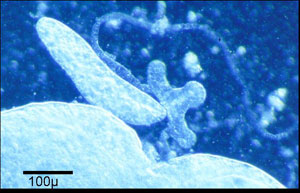
Fresh squash of Prosorhyncus squamatus released from a blue mussel.
This project focuses on two parasites affecting shellfish aquaculture in Atlantic Canada; Prosorhynchus squamatus, a digenean castrator in blue mussels and Haplosporidium nelsoni, "MSX" in American oysters. The infections pose no human health threat, but have impeded aquaculture development due to concerns about transfers between sites (inter- and intra-provincially) and the potential for spread.
The mussel castrator, P. squamatus, is a parasite that can cause castration of the blue mussel (Mytilus edulis), and, in severe infections, weakening and a diminished shelf-life. P. squamatus was not detected in mussels until 1997, which triggered restrictions on mussel transfers from castrator positive sites. To this end, a total of 5248 mussels (wild and cultivated) from Nova Scotia, New Brunswick, Prince Edward Island and Magdelan Island were analysed. Results suggest that the parasitic mussel castrator is normally a low level and sporadic infection which does not present a significant threat to Atlantic mussel populations. Regular monitoring of mussels for general health status should be sufficient to detect any changes in the low P. squamatus infection levels observed in this study.
MSX is a notifiable disease of concern listed by the Office International de Épizooties - OIE based on the devastating effects to oyster stocks this disease has caused along the mid-Atlantic coast of the US. Documenting distribution and monitoring mortalities is essential to ensure the most current information is available to fisheries managers and industry to allow aquaculture activities to continue while protecting uninfected stocks.
Research team: Mary Stephenson, Anne Veniot, Michelle Maillet, Richard Gallant, Neil MacNair, Andrew Bagnall, Abel Noel. For information contact Mary Stephenson (E-mail: StephensonM@dfo-mpo.gc.ca). Submitted by DFO (ACRDP).
Sept. '01-Mar. '06
Can rock crabs help with mussel culture?
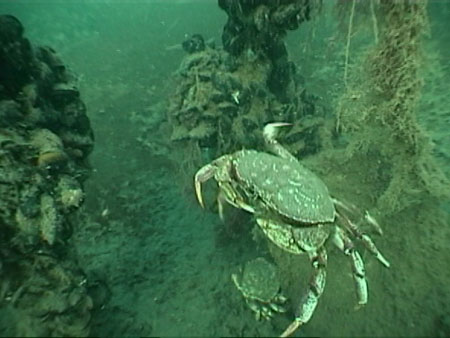
Rock crabs, pictures taken in Malpeque Bay, PEI
Due to an emerging demand for the rock crab, a directed fishery has evolved over the past twenty years. Concurrently, the mussel aquaculture industry has expanded considerably in many areas overlapping rock crab fishing grounds. One of the important husbandry methods employed by growers to reduce epifauna on mussel socks is to sink their longlines in order to benefit from rock crab predation. This is thought to help the consistency of mussels in a sock as well as to reduce the labour associated in cleaning the mussels destined for the market, but has not been tested scientifically.
Concerns have been raised by mussel growers as to possible impacts of the rock crab fishery within the growing areas. One assumption is that baited rock crab traps may increasingly lure rock crabs away from the aquaculture sites, reducing crab abundance and potentially the longline productivity. By scientifically testing that assumption, the results could improve the management of both industries. Another rock crab abundance risk factor is the presence of the invasive green crab in several areas of PEI, a potential competitor for habitat and food.
The project objectives are:
- to determine whether rock crabs are effectively attracted to mussel socks on a longline;
- to examine whether there is a decline in the abundance of rock crab on and under mussel lines during and following the directed fishery;
- to verify the widespread assertion that rock crabs are beneficial to mussel longline productivity;
- to evaluate the impact of the green crab on mussel line productivity.
Research team: Marc Ouellette, Luc Comeau, Jean-François Mallet and Angeline LeBlanc. For information contact Marc Ouellette (Email: OuelletteMC@dfo-mpo.gc.ca). Submitted by DFO (ACRDP).
Nov. '04-Mar. '08
Monitoring the health of soft shell clams and quahaugs in the Bay of Fundy
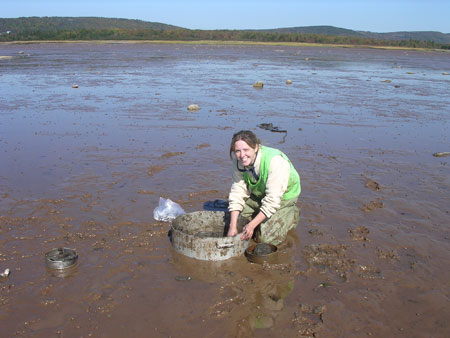
Leah Hamilton of Innovative Fishery Products at St. Mary's Bay, Nova Scotia
The shellfish aquaculture industry has grown significantly in recent years, mostly with the culture of the blue mussel and the eastern oyster, and has become an important part of the economy in Atlantic Canada. Research and development for diversification of alternate species such as the soft shell clam (Mya arenaria), the quahaug (Mercenaria mercenaria) and the bar clam (Spisula solidissima) have been particularly targeted because of their high market value. However, culture of these species has not attained a level of sustainability due to issues such as slow growth and erratic mortalities often attributed to limiting environmental factors and experimental husbandry techniques. A profile of diseases that could severely effect the development of the clam culture industry is required.
The goal of this research project will be to evaluate and monitor the health condition of two clam species, the soft shell clam and quahaug, in the Bay of Fundy with the following objectives:
- Update status of endemic diseases such as haemic neoplasia in softshell clams and QPX in quahogs.
- Screening of non-carrier species for OIE (Organisation International des Epizooties) listed diseases, such as MSX and SSO, found in Atlantic Canada.
- Evaluate the prevalence of shellfish diseases in relation to population dynamics and environmental parameters.
Research team: Marc Ouellette, Mary Stephenson, Angeline LeBlanc, Michelle Maillet and Leah Hamilton (Innovative Fishery Products). For information contact Marc Ouellette (Email: OuelletteMC@dfo-mpo.gc.ca). Submitted by DFO (ACRDP).
Jun. '05-Mar. '07
BC researchers monitor benthic impacts of a Pacific oyster farm
This study monitored particulate deposition rates, sediment geochemistry and benthic faunal communities at a deep-water, suspended Pacific oyster farm situated in Village Bay (Quadra Island), British Columbia. Reference stations were positioned at each end of a transect running through the centre of the oyster farm (> 500m from the farm perimeter); additional stations were positioned at 20m and 50m from either side of the farm perimeter; a central station was positioned at the oyster raft located close to the centre of the farm.
Benthic sampling was conducted every 3 months from July 2003 to August 2004. At most sampling dates, the organic carbon deposition rates were significantly higher at the central station (0.4 – 2.5 gC·m-2·d-1) than at all other stations (usually <0.5g·m-2·d-1). However, the oxidation reduction potential of the sediment below the central station did not differ significantly from that of the two reference stations at any sampling date. Furthermore, sulfide levels at the central station were only significantly higher than the reference stations on one sampling date. These results indicate that the increased organic input from the farm is not leading to consistently reducing sediments or sulfide accumulation in comparison to other locations within Village Bay. These results were consistent with the absence of any notable impoverishment in taxa number or abundance at the central station; these benthic communities were therefore not exhibiting any changes that would be associated with organic enrichment of the sediment.
Research team: Penelope Barnes (CSR). For information contact Penelope Barnes (Email: barnesp@mala.bc.ca). Submitted by BCARDC-AQE Fund.
Susceptibility of softshell clams to Haemic Neoplasia
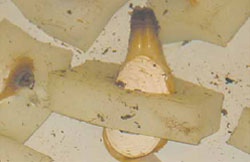

Results indicate that a relatively high prevalence and intensity of haemic neoplasia (HN) exists among softshell clam populations in Prince Edward Island. HN has also been detected at low intensity in several areas of the Gulf of St. Lawrence. Occurrence of HN has been associated with the presence of environmental contaminants.
The main objectives of this study were to identify the role of environmental watershed variables on the development of haemic neoplasia (HN) and to determine the potential genetic susceptibility of clams to develop this disease. The validation of a protocol in fl ow cytometry has allowed increasing diagnostic capacity compared to histology and cytology, the methods traditionally used.
Results indicate that a relatively high prevalence and intensity of HN exists in Prince Edward Island. HN is also detected at low prevalence and intensity in several areas of the Gulf of St. Lawrence. In the literature, occurrence of HN has been correlated with presence of environmental contaminants. After over 50 mm of rainfall in 24 hours, samples (water, sediment and clam soft tissues) were screened for 30 pesticides, including the three compounds most commonly used in agricultural activities. No pesticides were detected by mass spectrograph. Exposure experiments have also been performed to determine whether some fungicides would directly induce HN. After clams had been exposed to fungicides at concentrations ranging from 1 to 100 µg/l for six weeks, results were not conclusive, with no significant induction of the disease being observed in all treatments.
These results suggest that these contaminants may not directly induce development of haemic neoplasia in clams. The results imply a complex interaction along other factors, such as starvation, temperature stress, genetic susceptibility, presence of virus, etc. So far, all tested clam populations show similar susceptibility to develop HN after exposure to positive HN clams.
Research team: Réjean Tremblay, (UQAR), Jeffrey Davidson (UPEI), Thomas Landry (DFO), Emilien Pelletier (UQAR), Franck C.J. Berthe (UPEI), Julie Pariseau (UQAR), Stephanie Lynn Synard (UPEI). For information contact Réjean Tremblay (Email: rejean_temblay@uqar.qc.ca). Submitted by AquaNet.
Study to determine larval abundance and settlement of the blue mussel
For several years, mussel producers in the Gaspé Peninsula have been calling for larval monitoring studies in order to optimize mussel spat collection. However, the relationship between larval abundance, settlement success and success in collecting benthic invertebrate species is a complex issue. In fact, although a number of studies have described a relationship between the abundance of larvae that have reached the pediveliger stage and settlement success, this relationship has not been observed in other studies.
The general objective of this project is to acquire basic knowledge about the mechanisms governing larval distribution in order to determine peak periods of abundance, origin, and diversity of juvenile mussels in the case of two species (Mytilus edulis and M. trossulus) in the Gaspé Peninsula. Sampling to determine larval abundance and attachment success was carried out at the two production sites from June to October 2006. Characterization of the environmental factors required for modeling hydrodynamic conditions was also carried out during the summer of 2006, along with the histological analyses of wild and farmed adult mussels required for the description of the reproductive cycle. The other laboratory analyses will be conducted during the next two years.
Research team: Nathalie Rayssac, Réjean Tremblay, Jean-Marie Sévigny, Benoit Thomas and Vladimir Koutitonsky. For information contact Réjean Tremblay (Email: rejean_tremblay@uqar.qc.ca). Submitted by DFO (ACRDP), MAPAQ, SODIM and ISMER.
Apr. ’06-Mar. ’09.
Advancing mollusc diseases diagnosis in Canada
Infectious diseases are one of the major causes of economic loss in mollusk aquaculture and fisheries. Reliable and sensitive methods for detection of pathogens are essential to prevent their introduction or enable their management. Traditionally, diagnosis has been mostly based on histology. It is generally recognized that histology requires a high level of training and expertise. For this to be useful, we propose networking solutions for histology.
Real time histology sessions are established between distant laboratories by use of VNC technology associated to internet based phone solution. The project commonly uses real VNC and Skype. Training sessions have successfully been tested. It is expected that to become an increasingly used resource by surveillance networks, early warning and emergency response plans, as well as service, teaching and training facilities will be necessary. However, histology still holds limitations and there is a call for more rapid and sensitive methods.
The second aspect of our project was to develop flow cytometry procedures using specific antibodies to rapidly detect infectious disease along with the physiological status of the animals. In a first step we have developed a protocol for double labelling of neoplastic haemocytes based on propidium iodide stain and 1E10 as a way to assess the disease status of soft shell clam Mya arenaria with regards to haemic neoplasia. The validation of the procedure is still in progress; our next step is to develop similar procedures for infectious disease such as bonamiosis (Bonamia ostreae) of the European flat oyster, Ostrea edulis.
Research team: Frank Berthe (UPEI), Dave Groman (AVC), and Maryse Delaporte (UPEI). For information contact Frank Berthe (Email: fberthe@upei.ca). Submitted by AquaNet.
Jan. ’05-Apr. ’07.
Physiological and genetic bases of growth in the soft-shell clam
Knowledge of the physiological and genetic characteristics governing the growth of individuals is essential to the development of farm management methods that will eliminate individuals with poor growth potential. This goal can be achieved by applying selective methods or developing hatchery strains. However, it is important to preserve the resistance of the populations to environmental stresses and disease. The acquisition of sufficient genetic and physiological knowledge can significantly reduce this risk.
The main objective of this project is to determine the physiological and genetic characteristics that differentiate soft-shell clams, Mya arenaria, on the basis of their growth, in order to evaluate the possibility of developing a farm management method that maintains high growth rates without weakening the farmed stocks. To date, more than 300 individuals from different size classes have been sampled and transferred to the Pointe-aux-Pères station (ISMER) for a period of acclimatization to laboratory conditions. The experiments will be conducted during the winter of 2007.
Research team: Bruno Myrand, Réjean Tremblay, Jean-Marie Sévigny and Lise Chevarie. For information contact Réjean Tremblay (Email: rejean_tremblay@uqar.qc.ca). Submitted by SODIM, ISMER and ACRDP DFO.
Apr. ’06-Mar. ’07
Management of aquaculture site selection via regional Habitat Classification
Advances in survey instruments and Geographical Information Systems (GIS) can help improve the efficiency and scope of information available and provide a more eco-system view of environmental assessments, which can streamline the site assessment process for both regulators and farmers. This project evaluates using these innovative instruments for site assessments compared to traditional approaches.
In the spring of 2005, three coastal bays in Guysborough County, NS (Country Harbour, Marie-Joseph Harbour, and Tor Bay) were selected for study and plans were initiated for a comprehensive field sampling program. A GIS database was constructed from various sources, identifying sampling locations, as well as hypothetical farms for intensive surveys by remote sensing. A website for the project was also created to update partners on the progress of the project; refer to http://myweb.dal.ca/jgrant/ Guysborough.html for more information and images of the summer field program.
Field sampling was initiated in 2005 and all three bays were surveyed intensively with the remote sensing instruments (echosounder, Acrobat), and benthic-pelagic sampling (sediment grabs, water sampling, underwater video) was carried out. All data have since been added to the GIS database. The dataset will be further analysed using GIS and statistical methods. Analyses and reporting of the results will be completed by December 2006.
Research team: Jon Grant (Dalhousie U.), Peter Cranford (DFO), Rosaline Canessa (UVic). For information contact Jon Grant (Email: jon.grant@dal.ca; Website: Website: http://myweb.dal.ca/jgrant/Guysborough.html). Submitted by AquaNet
Bacterial breakdown of marine shellfish toxins
Paralytic shellfish poisons, or PSP’s are produced by marine dinoflagellates and can accumulate in the flesh of cultured bivalves such as clams, mussels and scallops. As their name indicates, PSP’s are toxic to humans and can cause death in those who consume contaminated shellfish. Some marine bacteria have been observed to grow on and decompose certain PSP toxins in vitro.
A strategy was developed in which toxin-degrading bacteria were fed to toxic shellfish in order to accelerate the speed of detoxification. Specific objectives were to screen toxic bivalves for bacteria that could degrade Paralytic shellfish poisoning (PSP) and/or domoic acid (also called Amnesic Shellfish Poisoning) in situ, isolate the enzyme(s) that degraded these toxins, and use a probiotic approach in depuration ponds by encapsulating the active bacteria and feed these to the toxic shellfish.
Toxic bivalves were successfully screened for bacteria that could degrade Paralytic Shellfish Poisoning (PSP) and/or domoic acid in situ. The ability to introduce the bacteria in large enough numbers and their effectiveness in completely breaking down toxins resulting in innocuous end products still needs to be determined. The outcomes of this project could result in significant benefits to the shellfish aquaculture industry if the appropriate toxin-degrading bacterial culture could be introduced into shellfish during commercial depuration procedures.
Research team: Tom Gill (Dalhousie University), Rafael Garduno (Dalhousie University), Michael Quilliam (Dalhousie University), Monica Bricelj (NRC-IMB). For information contact Tom Gill (Email: tom.gill@dal.ca).
Selective breeding for the bamfield Huu-Ay-Aht abalone
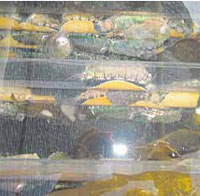
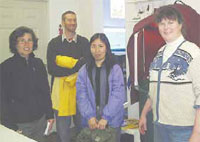
The challenge with designing a breeding program for highly fecund broadcast spawner like the pinto abalone is to avoid inbreeding. Most hatcheries do group spawning where 3 or 4 females are spawned with 3 or 4 males. However, our pedigree analysis with five microsatellite markers showed that in some spawning groups nearly all the larvae have been produced by only one female and one male. By using tentacle clips to monitor the relatedness of the broodstock we can maximize the number of parents that contribute to each generation, and increase the rate at which we can develop a new fast growing aquaculture strain of abalone.
To establish the breeding program we are doing a genetic evaluation, assessing the genetic merit, and predicting the response to the genetic selection program. The economically important traits include survival rates, age at harvest, and meat quality. We compared the economic values of these traits after genetic improvement to their base values, and determined which traits have positive effects on the profitability of abalone aquaculture operation.
Our breeding program will be applicable to any aquaculture species that has a high fecundity and prolonged larval stage that are reared in hatcheries without the facilities to rear each full-sibling family separately.
Research Team: Elizabeth Boulding, Yajie Liu, Matt Lemay, Ian Mcmillan, Rashid Sumaila and Jane Tosh in collaboration with Bamfield Huu-Ay-Aht Community Abalone Project and Ruth E. Withler (DFO). For further information contact Elizabeth Boulding (Email: boulding@uoguelph.) Submitted by AquaNet
Jan. ’05-Apr. ’07
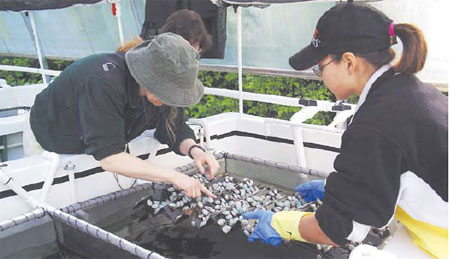
West Coast abalone researchers are undertaking a genetic evaluation of the species, assessing the genetic merit, and predicting the response to a genetic selection program. The economically important traits include survival rates, age at harvest and meat quality. They compared the economic values of these traits after genetic improvement to their base values and determined which traits have positive effects on the profitability of abalone culture operations.
Approvisionnement en naissain de mye au Québec

Experimental plots with nets for clam spat collection.
Juvenile soft-shell clams (Mya arenaria) can be supplied from three different sources: the harvesting of juveniles on natural beds, hatchery production and collection in the natural environment. The transfer of juveniles, although promising, was temporarily halted after several unsuccessful attempts. Efforts to produce spat in a hatchery were carried out in the last few years at the Centre aquicole marin de Grande-Rivière, but with mixed success. However, recent work carried out in the Magdalen Islands shows that it is possible to achieve good collection success by using various pelagic and benthic collectors. This type of test was reproduced with some success with benthic collectors (nets) in 2005 on a mud flat (Cran à Gagnon) on the Upper North Shore. However, the results achieved with other types of collectors as well as at other sites with a sandy substrate were mixed. In light of these results, the industry proposed repeating the tests at Cran à Gagnon in order to validate the observations made in 2005.
Gonadosomatic development was monitored from April to September in the Forestville sector in order to pinpoint clam spawning time. In the weeks following spawning, nets measuring 2.4 m x 7.6 m (mesh size of 6 mm x 8 mm) were positioned at the lower limit of the intertidal zone. The nets were placed directly on the fl at (the ends buried in a 30 cm deep trench) in order to promote the recruitment of the new cohort of clams. The experimental design included four experimental plots with nets and four control plots (without nets), all installed in June 2006. Three other types of pelagic collectors were tested at the same time in the infralittoral zone. An initial series of samples was collected prior to installation of the nets in June 2006; a second series of samples will be collected in the fall of 2006 and a final series in the spring of 2007.
Research team: M. Giguère, S. Brulotte, J.-M. Bélisle, Claudia Boisvert and Bernard Tremblay. For information contact Michel Giguère (Email: GiguereM@dfo-mpo.gc.ca). Submitted by SODIM and DFO
Apr. ’05-Mar. ’06
Controlling the clubbed tunicate in PEI
The clubbed tunicate (Styela clava), is a recent invader to Prince Edward Island (PEI) waters, and has had a particularly negative impact on mussel culture in the Murray River region. They attach in high densities to mussel socks and equipment, compete for food resources, foul equipment and could have a devastating effect on the PEI mussel industry. This research project focuses on determining the cause of death in tunicates to assist in identifying specific, environmentally acceptable chemical or biological solutions to target tunicates. The project also examines the effect of tunicate treatment on the physiological fitness of mussels and the ecology of the mussel sock.
Initial findings indicate that exposure to 5% acetic acid for two minutes results in mortality of the clubbed tunicate regardless whether the siphons are submerged or not. While the acetic acid has limited effect on some species in the aquatic environment, such as the lunar dove shell, it causes short and long term negative effects on the population dynamics of others, such as caprellid shrimp. The acid treatment causes mussel seed mortality, but does not affect mussel growth or genetic characteristics. The research will provide valuable information to formulating policies and standard operating procedures for treating tunicates with acetic acid.
Research team: Jeff Davidson (UPEI), Gerald Johnson (AVC); Thomas Landry (UNB). For information contact Jeff Davidson (Email: davidson@upei.ca) Submitted by AquaNet
Jul.’03-Jul.’06.
Optimizing scallop collection in the Magdalen Islands
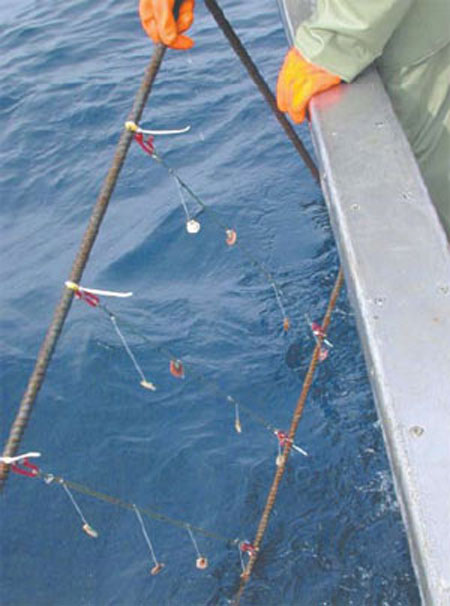
Research carried out in the Magdalen Islands over the last three years has established that weekly collection monitoring is a reliable tool for tracking changes over time in the attachment of scallops and undesirable species. This tool, which requires little expertise, is relatively easy for the industry to use. The results to date indicate that, with this tool, scallop growers can avoid the periods of peak mussel and hiatella attachment that occur before the beginning of scallop attachment by delaying the immersion of their collectors. The tool could also enable producers to decide to immerse collectors later in the season since weekly collection monitoring makes it possible to characterize changes in scallop attachment over time with some degree of reliability.
In the fall of 2003, the results of collector analysis during weekly monitoring revealed that very few hiatella, anomia and scallops had attached to the collectors. The same work in 2004, with recovery of a portion of the collectors by divers, revealed that very few organisms had detached during the process of raising the collectors into the boat, while the post-larvae (0.3 to 0.4 mm in size) could have passed through the mesh of the bags (2 mm). Another possible explanation of the low collection success for certain species could be linked to the effectiveness of the collector. In fact, a collector in which the collection substrate is not optimally conditioned (covered by a biofilm) would appear to be less effective for certain species.
In 2005, a study to verify this issue was conducted by the technical team from the Centre maricole des Îles-de-la-Madeleine in collaboration with the Pétoncles 2000 company. The goal was to evaluate whether it was possible to optimize collection on collectors conditioned in tanks before immersion in the sea. The results showed that a collector conditioned for two weeks in filtered seawater before being immersed in the sea provided a better collection substrate for scallops and, occasionally, for hiatella. However, despite these results and the few organisms that attached to the unconditioned collectors, weekly collection monitoring remains a reliable and accessible tool.
Research team: Carole Cyr, Georges Cliche, Jacques Richard, Jean- Guy Turbide, Claude Poirier, Michèle Langford, Francine Aucoin. For information contact Centre maricole des Îles-de-la-Madeleine (Email: stmim@mapaq.gouv.qc.ca). Submitted by DIT MAPAQ.
Combining shellfish aquaculture and marine protected areas
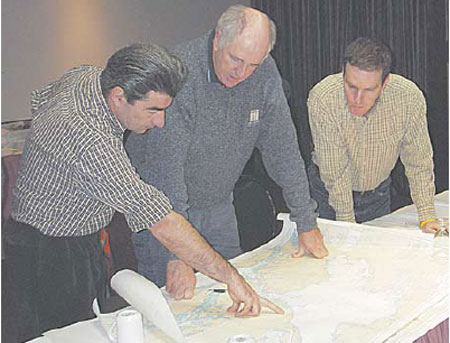
The project investigates various approaches to planning and management of coastal areas, and addresses the potentially conflicting interests of marine conservation, coastal tourism, First Nations and the needs of local communities.
This project explores approaches to planning and management of coastal areas that will address the potentially conflicting interests of marine conservation, coastal tourism, First Nations interests, and the needs of local communities. It includes examining perceptions of residents in the Gulf Islands, marine scientists and environmental groups regarding aquaculture in a nearby marine protected area (MPA). A second component assesses the role of stakeholder involvement in protected area decision making and compares these with other jurisdictions. The third component focuses on First Nations aspects regarding shellfish aquaculture and MPAs, taking into consideration the tensions between existing treaty processes, municipal regulations and constitutional litigation. This project will provide a comparison with experiences of indigenous groups in New Zealand.
The research to date has resulted in a comprehensive literature review of a collection of marine health indicators (biological, social, managerial), a web-based survey with marine scientists regarding the various indicators of marine health in a marine protected area, a focus group study with shellfish growers and a survey of residents of the Gulf Islands, BC, to measure their respective perceptions of the compatibility of shellfish aquaculture and MPAs; a study of legal implications of First Nations’ involvement in shellfish aquaculture; and a comparison of New Zealand and British Columbia. Key policy and governance issues for planning and managing MPA were identified as well as a lack of knowledge about shellfish aquaculture among many stakeholder groups, resulting in a negative bias against shellfish aquaculture.
The research in New Zealand included several public lectures including at the National Institute for Water and Atmospheric Research (NIWA) and the New Zealand Institute for Economic Research. NIWA’s Maori Research Unit has expressed interest in working with the Canadian researchers on a project that would partner a First Nation community on the west coast with a Maori community where NIWA has secured three-year funding to run a small-scale, shellfish aquaculture training project.
Research team: Rick Rollins (MUC), Jeremy Rayner (MUC); Chris Tollefson (UVic). For information contact Rick Rollins (Email: rollins@mala.bc.ca). Submitted by AquaNet.
Apr. ’03-Mar. ’06
Dynamic of haemic neoplasia in soft-shell clams
Some of the molecular mechanisms of haemic neoplasia (HN) in the soft-shell clam, Mya arenaria, have been identified. Several studies have demonstrated the role of proteins belonging to the p53 family in the process of this disease. This makes haemic neoplasia and Mya arenaria an interesting model in comparative oncology. While p53 is expressed in both normal and leukaemic cells, previous studies have shown specific expression of a p73 in leukaemic cells. Mutation of the gene coding for p53 has also been suggested in the process of the disease. More recently, a mortalin-based sequestration of p53 in the cytoplasm of leukaemic cells is proposed as an essential mechanism of neoplasia. However, there is still little information on the dynamic of this family in the course of the disease.
Our study focuses, in a first attempt, on expression of p53 and p73 genes in leukaemic clams. An HN positive clam population is monitored by western blots and quantitative RT PCR. Detection of mutation is based on SSCP and western blot using monoclonal antibody Pab240. With time, our main objective is to identify the molecular actors involved in the development of leukaemia.
Research team: Réjean Tremblay (UQAR), Jean-Marie Sévigny (UQAR), Franck C.J. Berthe (UPEI), Ahmed Siah (UPEI), Julie Pariseau. For information contact Réjean Tremblay (Email: rejean_temblay@uqar.qc.ca). Submitted by AquaNet.
Jun.’06-Jul.’07
Studying Shellfish Disease at the Pacific Biological Station
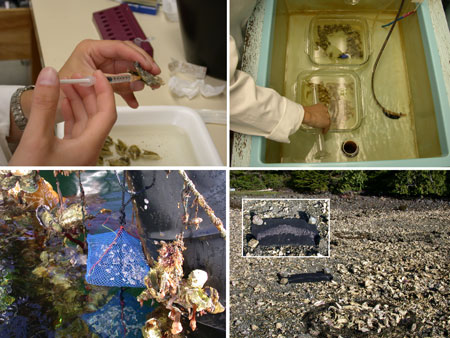
Methods used to experimentally expose mollusks to pathogens (from top left): inoculation, slurry of infective stages mixed with algal feed, and cohabitation with cultured stocks in lantern nets on long-lines and in vexar pouches on the beach.
Since the late 1980s, the Shellfish Disease Research Unit at the Pacific Biological Station in Nanaimo has been investigating infectious diseases of shellfish that occur on the Pacific coast of Canada. Discoveries include the identification and description of several new disease agents and parasites including the following Protista: Labyrinthuloides haliotidis a thraustochytrid lethal to newly settled abalone; Perkinsus qugwadi that seriously curtailed the development of scallop culture in B.C.; an unnamed pathogen of spot prawns(SPP); Margolisiella kabatai and Pseudoklossia semiluna, in the kidney of native littleneck clams and mussels, respectively; a ciliate Stegotricha enterikos that utilizes the digestive tract epithelial cells of oysters; and a rickettsia-like eukaryote in spot prawns that affects market acceptability.
Current research includes identifying the biology of Mikrocytos mackini which is of international significance to the production of oysters in cool habitats and determining the distribution and identity of a coccidia that infects the kidney of abalone. Recently, the Unit has taken on the challenge of supporting the new National Aquatic Animal Health Program to provide laboratory diagnostic support to the Canadian Food Inspection Agency in establishing shellfish products from B.C. as free of OIE (World Organisation for Animal Health) listed diseases.
Research team: Susan Bower and Gary Meyer. For information contact Susan Bower (Email: Bowers@dfo-mpo.gc.ca). Submitted by DFO (ACRDP).
Brine treatments used to improve mussel collection in Quebec
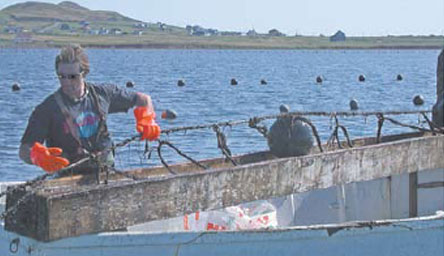
A team from the Centre maricole des Îles-de-la-Madeleine (CeMIM) has been working for several years to characterize the process of attachment used by mussels and other organisms at the region’s main collection site.
The effectiveness of brining as an agent for controlling starfish, the main predator of mussel spat, was demonstrated several years ago. The experiment revealed that the ideal duration of treatment is around 30 seconds, and that the optimal treatment period can extend over several weeks. However, mechanization of operations make it necessary for the benefits of such an operation to be validated on a commercial scale.
In the summer of 2005, the Société de développement de l’industrie maricole du Québec (SODIM) therefore joined forces with the CeMIM team in order to verify the costeffectiveness of the operation of brining collectors infested with starfish. By simply comparing sections of collector lines brined in August and unbrined sections on the same lines, it was estimated that each of the two mussel growers in the region could have harvested several million additional young mussels in the fall by brining their collectors.
While it would have cost each mussel grower in the Magdalen Islands approximately $4,000 to brine all their lines, the operation would have enabled them to harvest an additional 12 to 16 tonnes of spat. It is reasonable to assume that the additional spat production obtained by brining could generate net revenues of several thousand dollars. The project resulted in a series of recommendations which were distributed to all mussel growers in Quebec to encourage them to adopt the practice.
Research team: François Bourque, Bruno Myrand, Jules Arseneau, Francine Aucoin, Yvon Chevarie, Michelle Langford, François Gallien, Jacques Richard, Annie Renaud. For information contact Centre maricole des Îles-de-la-Madeleine (Email: stmim@mapaq.gouv.qc.ca). Submitted by DIT MAPAQ.
Investigating the effect of skeleton shrimp on mussel spat recruitment
In 2003, mussel growers in the Carleton region reported unprecedented populations of skeleton shrimp on spat collectors and holding lines. This phenomenon appeared to be accompanied by relatively low spat collection rates.
The purpose of this project is to determine whether skeleton shrimp are harmful to mussel culture. To achieve this goal, the project will comprise the following components: 1) study of mussel spat set density and skeleton shrimp biomass as a function of depth; 2) study of the diet of skeleton shrimp; because the stomach contents of skeleton shrimp are frequently too degraded to permit direct identification, we must use an immunological approach. This method is based on detection of the presence of mussel tissue by examining the agglutination response of an appropriate antibody when placed in the presence of material from the digestive tract of skeleton shrimp; 3) study of the biomass and size/age structure of existing skeleton shrimp populations as a function of depth and period in the season; 4) study of the effect of various line weight-line maintenance protocols on skeleton shrimp populations.
The few preliminary results currently available indicate that skeleton shrimp populations on spat collectors decreased in 2006; it also appears that during the 2004-2005 period, skeleton shrimp did not adversely affect mussel spat collection, unlike other epibionts. Using new weight lines reduces the number of skeleton shrimp and hydrozoans, while manual cleaning of the weight lines has no effect. Mussel spat collection tends to be higher on the control weight lines. The results of immunochemical tests indicate that skeleton shrimp do not feed on mussel larvae or spat.
Research team: Marcel Fréchette, Bernard Sainte- Marie, Christian Turcotte, Linda Girard, Marie-Claude Marquis (MLI, DFO); Réjean Allard. For information contact Marcel Fréchette (Email: FrechetteM@dfo-mpo.gc.ca). Submitted by SODIM
Jul. ’04-Mar. ’07
Researchers test new intermediate culture techniques for scallops in the Mingan Islands
The scallop farming strategy generally relies on spat collection, subsequent transfer of the spat to pearl nets, followed by bottom seeding or transfer to lantern nets. Each of these steps is very labour intensive. One way of minimizing the effort invested in these operations is to bypass one or more of the steps in the production chain described above. An approach being considered in this project is to allow the spat in the collection bags enough time to reach a sufficient size so that the pearl net step can be skipped. One condition required for this scenario to work is the number of spat attached to the bags must be high enough for the operations to be worthwhile, yet low enough to prevent overcrowding in the collection bags. The biomass-density relationship can be used to study this aspect.
To study this relationship, we collected spat at two sites in the Mingan Islands and at different heights from the bottom, which normally yields a gradient in the initial numbers. As the project continues, spat are then recovered after one year and two years in the collection bags. The following variables are studied: the size of the scallop and other shellfish specimens, the numbers of the various species and the height of the bags from the bottom. We will also conduct sampling of the fluorescence and the temperature of the water column. The initial results indicate that growth varies with height from the bottom, which is a classic response. These results also indicate the existence of interspecific competition among scallops (Chlamys islandica) and other shellfish (Hiatella arctica for example).
Research team: Marcel Fréchette, Linda Girard (MLI, DFO); Martin Guay (Centre aquacole de la Côte-Nord). For information contact Marcel Fréchette (Email: FrechetteM@dfo-mpo.gc.ca). Submitted by SODIM.
Aug. ’04-Mar. ’09
Shellfish Longlines
In previous work, Institute for Ocean Technology (IOT) researcher Dr. Wayne Raman-Nair, in collaboration with Mr. Pierre Bergeron and Marc Gagnon of BIOREX Inc. of Quebec, has developed numerical models of submerged shellfish longlines. These models have been developed into a software product that allows shellfish growers to estimate loads induced by environmental and routine servicing actions. The current work is continuing to develop the models and software to provide more accurate predictions. In 2005, IOT and Biorex conducted in-situ drag trials on various components of a typical shellfish farm including spat collectors, various buoys with and without fouling and the shellfish socks themselves. The data from these experiments was used to provide more accurate drag coefficients for the simulation software and to quantify the effects of marine fouling in increasing the drag. Following this a second-generation simulation package was developed that allows the motions and orientations of the shellfish socks themselves to be more accurately determined. This software is currently undergoing testing and evaluation at Biorex.
Research team: Wayne Raman-Nair, Pierre Bergeron and Marc Gagnon (Biorex Inc.). For information contact Bruce Colbourne (Email: D.Colbourne@nrc-cnrc.gc.ca). Submitted by NRC.
Monitoring mussel larvae and spat in the Gaspé Peninsula
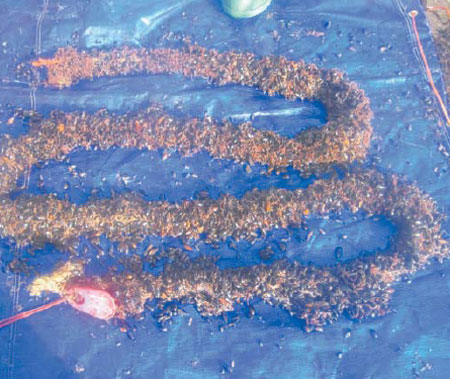
Mussel collector retrieved to identify the optimal period of spat attachment in the Gaspé Peninsula.
For a second year, the peak presence of mussel larvae about to undergo metamorphosis and the peak level of mussel spat attachment were identified in the two mussel culture sectors of the Gaspé Peninsula: Tracadigache Bay and Gaspé Bay. Every week from mid-May to mid-October, at each of three selected sites, mussel growers collected samples by pumping for 10 minutes between 1 and 8 m from the surface; the samples were then filtered using three screens (780, 390 and 80 µm).
Results obtained in the Cascapedia Bay sector included the appearance of small larvae (new cohort) beginning in mid-June. In the Gaspé sector, three cohorts of small veliger larvae were observed, as in 2004, including a very large peak around mid-July. Until late June, the average size of the larvae in Cascapedia did not exceed 200 µm and although larger sizes were found in Gaspé slightly earlier, their density remained very low. As in 2004, the density of the spat collected on the lines in Gaspé was higher, but the average spat size was nearly half that observed in Cascapedia.
Research team: B. Thomas, N. Rayssac, R. Tremblay and J.-M. Sévigny, R. Allard and staff, N. Bouchard, J. Bourgoing, J. Cauvier, J.-C. Cloutier, D. Fortin, R. Joncas, S. Morissette and staff, and M.-P. Turcotte. For information contact Benoit Thomas (Email: benoit.thomas@mapaq.gouv.qc.ca). Submitted by MAPAQ, SODIM, ISMER and DFO.
Development of soft-shell clam culture in Quebec

Clam culture is generating interest in Quebec, particularly in the Magdalen Islands. "Myiculture aux Îles-de-la-Madeleine" (MIM), a five-year research and development program, was carried out between 2000 and 2005. A new five-year program, MIM-II, began in 2006. Several activities of the first and of the new program were conducted in parallel.
At the present time, work is focused on ensuring a supply of spat, specifically with benthic mats (Astroturf). Suspension collectors are also being tested. In the fall, the young clams from the collectors measured 8 mm on average. Overwintered in suspended structures under the ice cover, they are still too small to be seeded the following summer. A pre-growout phase must therefore be added to obtain 15 to 20 mm clams for seeding operations. It has been discovered that this size minimizes losses by predation, dispersion and natural mortality. Various nursery approaches are being compared FLUPSY, floating bags and even buckets filled with sand) to determine the most efficient and most cost-effective method. Several experimental seedings are carried out each year. The experimental plots are covered with a net (4 mm mesh size) during the entire first summer season. Growth and recovery of the seeded clams are then monitoring by regular sampling. Economic scenarios are developed with the data obtained and regularly updated.
Research team: Lise Chevarie, Bruno Myrand, Réjean Tremblay. For information contact Bruno Myrand (Email: bruno.myrand@mapaq.gouv.qc.ca). Submitted by DIT MAPAQ.
Why and how mussel attachment strength varies
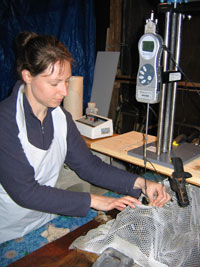
Researchers seek a better knowledge of changes in mussel attachment strength over time and the factors that influence it.
During the summer period, falloffs of mussels from suspended socks can be significant. Reducing these losses would increase the profitability of mussel culture operations. These fall-offs are most likely related to the strength of the attachment of the mussels to each other as well as to the culture substrate. Better knowledge of changes in attachment strength over time and of the factors that influence it would make it easier to devise solutions.
Research into this problem was carried out in 2004 (late June to mid-October). The weakest attachment strengths were observed from mid-July to mid-August. Attachment strength then regularly increased during the fall, to levels as much as 2.3 times higher than in mid-July. The work was repeated in 2005, beginning in late May. The main findings were: (1) the significant decline in attachment strength in summer appears to be associated with spawning, (2) the increase in the fall appears to be associated with increased water turbulence, (3) the difference was approximately 1.9 X between extreme values, and (4) the mussels were more strongly attached in 2005 than in 2004. A number of other biological and environmental parameters are currently being analysed in order to more clearly identify the factors involved in the variability of attachment strength on socks.
Research team: Andrée-Anne Lachance, Bruno Myrand, Réjean Tremblay, Jean-Marie Sévigny, Vladimir Koutitonsky, Emily Carrington. For information contact Bruno Myrand (Email: bruno.myrand@mapaq.gouv.qc.ca). Submitted by MAPAQ, ISMER and ACRDP DFO.
Apr. ’05-Mar. ’06
Researchers evaluate scallop spat losses in Gaspe Bay
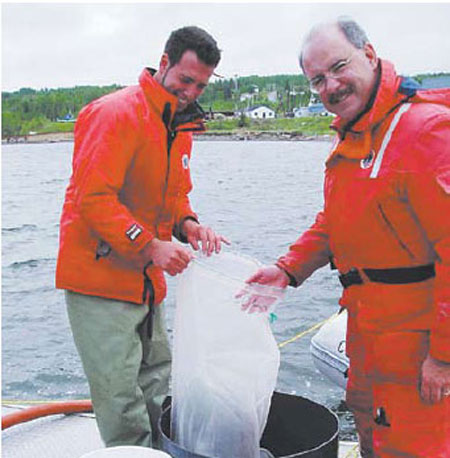
The project aims to monitor scallop spat losses and determine the best time for large-scale retrieval of the collectors.
Monitoring sea scallop collectors in the Gaspé Peninsula and the Magdalen Islands revealed that 70% to 90% of spat were lost before the collectors were raised at the end of the summer. Adoption, by the project proponent operating in Gaspé Bay, of an intermediate culture strategy to optimize collection therefore requires that the condition of the collectors first be determined and that changes over time in terms of scallop size and losses be monitored.
The number and size of scallops on the collectors will be estimated by sampling, to be carried out every two weeks by divers who will retrieve five collectors per line on each of three lines. Between late May and early November, up to 14 sampling periods could occur. The 15 collectors will be cleaned and sorted in the laboratory in the days following their retrieval in order to determine the progression of losses and growth of the scallop spat and the amount of fouling, thus helping to identify the best time for large-scale retrieval of the collectors by the proponent. Based on the results of the first season of the project, a progressive loss of spat was in fact seen from the start of sampling in mid- June until late July. From that point on, the average quantity of sea scallop spat per bag remained stable until the end of collection in early November.
Research team: B. Thomas, M. Giguère, J. Richard.. For information contact Benoit Thomas (Email: benoit.thomas@mapaq.gouv.qc.ca). Submitted by MAPAQ.
Recent measurements of the dispersion of soft-shell clams seeded in the Malbaie barachois
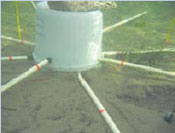
Project to monitor the survival and retrieval rate of soft-shell clams in the Malbaie barachois in the Gaspé Peninsula.
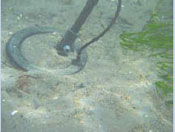
Metal detector used to locate tagged clams in the Malbaie barachois in the Gaspé Peninsula.
Between 2003 and 2005, research was carried out on softshell clams (Mya arenaria) in the Malbaie barachois in order to measure their displacement distance, determine the direction of these movements and estimate their survival as well as the return rate following seeding.
A total of 480 clam specimens, 35-40 mm in size, were measured, numbered and tagged with a small metal pin. The clams were spread over 10 plots. On each plot, 48 clams were placed in groups of six, at 20 cm intervals, on each of the eight axes of a grid oriented according to the cardinal points.
During subsequent monitoring, the clams were located using a metal detector along the axes of the grid, relative to their initial position. In October 2003 and July 2004, all the clams on a certain axis were retrieved and five new plots containing 240 clams from a second size class (25-30 mm) were added and monitored until the fall of 2005. Despite annual fluctuations, commercially seeded clams are expected to have very limited movements. The majority of the clams did not move. Where movements were calculated, they may have been influenced by other environmental conditions and the direction of the currents at the time of seeding.
Research team: B. Thomas, M. Giguère and S. Brulotte. For information contact Benoit Thomas (Email: benoit.thomas@mapaq.gouv.qc.ca). Submitted by MAPAQ, SODIM, and DFO.
Growth of sea scallop spat studied in Gaspe Peninsula
Monitoring of the growth of sea scallop spat recovered from the collectors of a project proponent in the fall of 2000 and from collectors during the 2003 collection optimization project was continued in lots maintained in Cascapedia and Gaspé bays. The various lots from the 1999 collectors, collected, sorted and transferred to nets in 2000, reached an average size of nearly 100 mm by the fall of 2005. The spat from the 2003 collectors reached a size of nearly 60 mm in the same period. In the various cases, few differences were observed in growth between the lots maintained in Gaspé and in Cascapedia. Manipulations at low salinities during spring monitoring in Gaspé is probably responsible for the high mortalities observed between the spring of 2005 and the next monitoring phase conducted in the summer. Despite these incidents, the monitoring demonstrated that the production cycle, although not optimized, could extend over more than five years, including collection.
Research team: B. Thomas. For information contact Benoit Thomas. For information contact Benoit Thomas (Email: benoit.thomas@mapaq.gouv.qc.ca). Submitted by MAPAQ, SODIM, and DFO.
The Sustainable Shellfish Aquaculture Initiative at Simon Fraser University
In February 2002, Simon Fraser University was awarded a 5 year National Science and Engineering Research Strategic Grant entitled "Towards a sustainable shellfish industry". The overall long-term objective of the strategic grant was to provide to the shellfish industry required information for sustainable farming of the foreshore without harm to the environment. The specific objectives of the research project were to determine how shellfish farming practices influenced:
(1) the geochemical cycles of carbon, phosphorous, and nitrogen within the intertidal region
(2) species diversity, abundance, and distribution within the intertidal
(3) migratory birds (shorebirds and sea ducks), which rely on the intertidal for at least some part of their life history.
These objectives were conducted in three geographically distinct areas on the coast of British Columbia, including Baynes Sound, Malaspina Complex and Desolation Sound and Barkley Sound. Research outcomes are now being written and submitted to peer review journals for publication.
Research team: Leah Bendell-Young, Sean Boyd, Rob Butler, Dan Esler, Patricia Gallaugher, Ron Ydenberg. For information contact Leah Bendell-Young (Email: bendell@sfu.ca; Website: http://www.sfu.ca/coastalstudies/ssai).
Investigating the Effects of Clam Nets
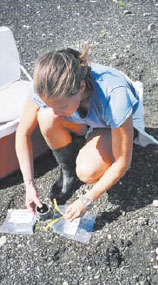
Daphne Munroe taking a settlement sample.
Predator nets used for culturing Manila clams in British Columbia are laid on intertidal sediments and thereby could possibly interrupt tidal flows and influence larval settlement and sediment properties. The influence of intertidal clam netting on the distribution of settling pediveliger larvae was investigated by examining early recruitment patterns of Manila clam larvae (Venerupis philippinarum) in relation to predator netting. Recently settled clams (<600 µm shell length) were sampled from netted and non-netted sites in Baynes Sound, on the eastern side of Vancouver Island, British Columbia. Plots with netting and high density of adult clams experienced lower levels of settlement. Settlement was variable annually with 2003 experiencing an order of magnitude less recruitment than 2004.
Sediment properties (sediment grain size, organic carbon and inorganic carbon) were also compared between netted and non-netted plots. No difference was seen in the sediment properties measured except for slightly higher levels of organic carbon beneath nets; this was likely due to the higher number of adult clams beneath the nets. Overall, no measurable increase in sedimentation beneath netting was noted; however, decreased settlement beneath netting was observed in the year when overall settlement was high.
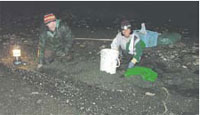
Student volunteers Kent Williamson and Edith Billington take shellfi sh samples on a night tide.
In addition, laboratory tests were run using flumes to examine the retention of competent clam larvae within flumes with netting on the bottom. No difference in the retention of clam larvae was observed due to netting or sediment treatments.
Research team: Daphne Munroe, R. Scott McKinley, William Pennell, Neil Bourne and Doug Bright. For information contact Daphne Munroe (Email: dmmunroe@interchange.ubc.ca) Submitted by NSERC.
Jan. ’02-Aug. ’06
Researchers seek to optimize floating nets for shellfish rearing
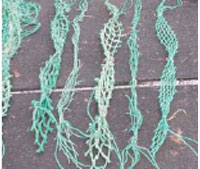
The project provided information about the various types of floating nets, the outside forces affecting them, and how differently shaped floating nets behave in different conditions.
In Quebec, submerged floating nets have been used for commercial mollusc farming since the mid-1980s. At first, these rearing structures were designed on the basis of techniques developed elsewhere, especially Prince Edward Island, and numerous changes were made over the years to adjust them to the severe conditions that prevail on Quebec coasts. Despite this, Quebec sea farmers are still having a number of technical problems, especially when rearing sites are relatively unprotected from waves, winds and ice. The high risk of floating net loss and damage represents a major limiting factor for new firms and industry growth.
Despite all the experience accumulated by producers and the ingenious solutions they have found to enhance farm yields there remains poor understanding of how the nets and their anchorages behave when swept by currents, winds and swells. So it is not surprising to find that we have few specific criteria for shaping nets and choosing anchorages to reflect the physical features of rearing sites. These criteria are desirable, however, to further stabilize floating nets deployed at sea and cut the costs of manufacturing, installing and maintaining these structures. This is why the Regroupement des mariculteurs du Québec (RMQ) and SODIM have mandated the Biorex firm to help Quebec sea farmers learn more about rearing structures.
This initial mandate produced certain basic rules to govern the design of floating nets and make them more stable at sea. The research also provided information about the various types of floating nets, the outside forces affecting them and how differently shaped floating nets behave, and should make for better long-term buoyancy management. As well, this study included the development of simulation software to help sea farmers configure their submerged nets to reflect the features of their rearing sites. This software accommodates various net configurations (changing, for example, buoy sizes and numbers, rope length and elasticity or bearing line height above the bottom) and enables us to calculate the nets’ position and inclination above the bottom, tension in lines and the pull of anchorages in different current and swell conditions. However, the main factor limiting the use of this software is the shortage or absence of data for a number of parameters in the model. The simulation results could be made more accurate by adding data on the environmental characteristics of rearing sites (including the speed of currents), the mass of rearing media in the water and the mechanical properties of the components (the drag coefficient when dirt is present, resistance to the pull of anchorages and the elasticity of ropes). Therefore, the BIOREX firm was handed a second mandate to conduct new digital simulations with more accurate data for the modelling parameters. This new study, which began in fall 2005 to continue over two years, will increase the accuracy of the parameters used to model the submerged floating nets and conduct simulations that will optimize the design of these nets by incorporating data on resistance to the pull of anchorages and abrasion of mooring lines. Despite the range of phenomena that can arise from year to year, optimizing the use of floating nets by computer modelling of rearing parameters will certainly give sea farmers an added tool to further improve their rearing practices.
Research team: Robert Vaillancourt. For information contact Robert Vaillancourt (Email: Robert.vaillancourt@sodim.org). Submitted by SODIM.
New seeding strategies developed for the sea scallop
Seeding of juvenile sea scallops has been carried out annually in the Magdalen Islands for more than a decade in order to compensate for the drastic drop in wild stocks that occurred in the late 1970s. The commercial strategy chosen involved annual seeding of scallops 20-40 mm in size following intermediate culture in a lagoon for approximately nine months.
The first objective of the project will be to assess the information available concerning optimal scallop size at seeding. The second objective will be to conduct a field study in order to assess the survival of scallops seeded directly from collectors without sorting (5-20 mm) as compared with the survival rate of scallops seeded directly from collectors after sorting (5-20 mm), scallops that go through an intermediate culture phase in a lagoon for approximately nine months according to the conventional method (20-40 mm), and scallops that have a grow-out period of approximately one year and nine months (40 mm and over).
Each strategy will be evaluated for scallop survival rate and these data will be compared with the associated costs to determine the most cost-effective method.
Research team: Hugo Bourdages, Madeleine Nadeau, Sylvain Vigneau, Robert Vaillancourt, Michel Giguère, Mélanie Bourgeois and Patrice Goudreau. For information contact Hugo Bourdages (Email: BourdagesH@dfo-mpo.gc.ca). Submitted by MAPAQ, SODIM, ACRDP DFO.
Oct. ’06-Mar. ’10
Producing blue mussels on "self-operating collectors"
In eastern Canada, mussels are reared in socks suspended from fixed lines. The lines are maintained at a constant depth and require regular maintenance inspections and significant efforts for spat collection and socking. In addition, suspension culture involves periods of intense activity that leave very little time for other tasks. The purpose of this project is to complete the development of a mussel culture strategy that would allow fishers to engage in suspension culture while avoiding conflicts with the fishing season, which would offer a possibility for diversification of the fishers’ traditional activities.
One possible way to achieve this objective is to culture mussels on "self-operating collectors", which would require very little line maintenance and would make it possible to avoid socking. One possible drawback is that because the seed would not be graded to size, product quality would be more variable. The project includes comparing the commercial production of the "self-operating collectors" and of traditional socks, monitoring the depth of the "self-operating collectors", conducting a bioeconomic analysis and establishing the biomass-density relationship for the mussel populations of the "self-operating collectors" in Cascapedia Bay.
Research team: Marcel Fréchette, Myriam Lachance-Bernard, Linda Girard, (MLI, DFO); James Wilson, Francis Bilodeau (UQAR); John Himmelman (Laval University); Éric Bujold. For information contact Marcel Fréchette (Email: FrechetteM@dfo-mpo.gc.ca). Submitted by SODIM.
Apr. ’03-Mar. ’07
Growth of clams in the St. Lawrence Estuary
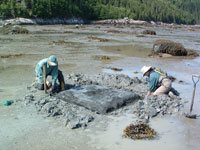
Installation of an experimental plot for in vivo growth of the clam.
A number of studies have shown that temperature, food quality and availability, immersion time, salinity, dissolved oxygen, density of individuals, substrate, current, exposure to waves, pH and quantity of suspended matter can affect the growth of the soft-shell clam (Mya arenaria). In addition to these factors, the effect of biological factors on growth, such as sexual maturity, must also be considered. Research carried out in Quebec in the last few years has indicated that the site, where a number of the abovementioned variables are factors, had a predominant effect on clam growth. In the St. Lawrence Estuary, the variables affecting clam growth are poorly documented at present. Of the above-mentioned variables, sexual maturity, immersion time and food supply were identified as priorities for in-depth evaluation during this project.
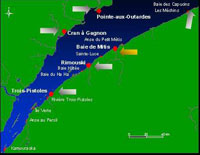
Experimental sites for clam growth in tanks (yellow) and in the field (grey).
In 2005, clam size at sexual maturity was studied for seven beds in the St. Lawrence Estuary and the Gulf of St. Lawrence. The preliminary results of this research indicate that size at maturity is similar in the case of clams from the Estuary and Gulf of St. Lawrence, but smaller in that of clams from the Magdalen Islands. Research aimed at measuring the effects of immersion time and food supply was initiated in tanks at the Maurice Lamontagne Institute, and in the field on five beds in the St. Lawrence estuary. The variability, both intra-bed and inter-bed, of growth, survival and dispersion rates was studied. The knowledge gained through this project will contribute to our understanding of the biology of the soft-shell clam and help in the selection of seeding sites suitable for clam culture in the Estuary and Gulf of St. Lawrence.
Research Team: M. Giguère, S. Brulotte, J.-M. Bélisle, Marie-France Dréan, Annabelle Bourget, Bernard Tremblay, Claudia Boisvert and Madeleine Beaudoin. For information contact Michel Giguère, (Email: GiguereM@dfo-mpo.gc.ca). Submitted by SODIM and DFO (ACDRP).
Apr. ’05-Mar ’07
Researchers test spat collection methods for the soft-shell clam
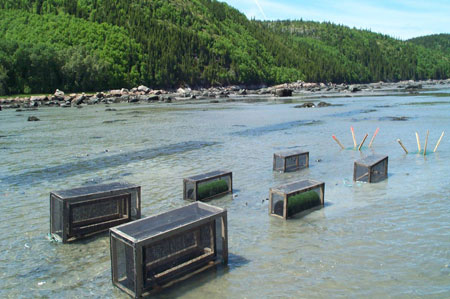
Experimental designs used to collect clam spat.
The objectives of this project were to evaluate four spat collection techniques for soft-shell clam (Mya arenaria) in an open environment on the north shore of the estuary and Gulf of St. Lawrence in order to estimate their respective collection success and identify the advantages and disadvantages of each of the techniques used. Field work was carried out in 2005 on the Cran à Gagnon and Pointe-aux-Outardes flats on the Upper North Shore. Collection trials were conducted on these two beds using nets placed directly on the substrate. Collection trials using three different types of cages as well as Astroturf mats were also conducted near the nets at the Cran à Gagnon site. Random sampling of the sediments was carried out in June and October 2005 on all the experimental plots and the control plots. The cages and mats were sampled in October 2005 only. The results obtained at Cran à Gagnon indicated that the collection rate was 10 times higher under the nets than in the control sites without nets. The results obtained with the other types of collectors placed at Cran à Gagnon were mixed. The results achieved at Pointe-aux-Outardes with nets were negligible. Three months after deposition of larvae, the average size of the clams collected was less than 3 mm. Of the various collection techniques used, the net appears to be the most promising.
Research team: M. Giguère, S. Brulotte, J.-M. Bélisle, Marie-France Dréan, Marie-Karine Maltais, Claudia Boisvert and Bernard Tremblay. For information contact Michel Giguère (Email: GiguereM@dfo-mpo.gc.ca) Submitted by SODIM and DFO.
Apr.’05-Mar’06
Shetland Island mussel spat collectors tested in Quebec
The mussel collectors and rearing media used in Quebec generally consist of a rounded section of rope. The mussels settle there, but with time and growth their density becomes very high for the available surface. This situation is thought to cause the release of some of the mussels, generally at harvest time.
A 2005 trade mission of Quebec mussel farming industry representatives introduced them to the collection and rearing systems used by mussel farmers in Scotland and the Shetland Islands. Some of them practice the SMART system with wide-mesh, heavy-gauge netting as the collection and rearing medium. One of the major Shetland Islands producers uses this principle for spat collection and rearing on collectors, cutting handling and thus labour requirements. These collectors consist of the edges of fishing nets dropped from a head line. This is felt to give the spat a bigger surface to settle and grow on. The success of the harvest would thus be improved.
Discussions on returning from the mission came up with the hypothesis that this approach to collecting and rearing on collectors would be of interest for Quebec and a project was developed. The main objective being to test the efficiency of mussel spat collectors made of net mesh edges. The secondary objective is a preliminary assessment of the advantages and drawbacks of this kind of collector for rearing purposes.
The project is ongoing in Cascapédia Bay with input from a mussel farmer. The spat was collected in early July 2006, and these structures will be monitored until the summer of 2008. Five types of media are being tested, all made of nets originally intended for trawling. Each collector is deployed vertically with the top attached to the net’s head line at a depth of 1 m. A weight is attached to the collector’s lower part to keep it in a vertical position: collector depth thus varies from 1 to 2.60 m.
At the time of deployment, the netting is rolled up and lashed with biodegradable wire, making a cylinder 1.60 m long. After the collection period, the wire is destroyed and the medium resumes its form as an edge, increasing the attachment surface and reducing mussel density by unit of length on the medium, though without cutting the number at the foot.
Regular 1.60 m collectors have also been deployed as controls beside these experimental collectors. Twelve experimental collectors of each type (thus 60 in all) and 12 regular collectors were deployed in July on the collection site of the farmer working with the project. Three of the 12 collectors of each type of medium will be brought up for monitoring purposes at four periods, September 2006 (after collection), November 2006 (before wintering), June-July 2007 (after one year of growth) and June-July 2008 (after two years of growth).
As well, information on ease and time of manufacture and use will be noted throughout the project so the advantages and drawbacks of these collectors can be weighed in both economic and biological terms. Recommendations for the industry will be developed with the final report.
Research team: Robert Vaillancourt. For information contact Robert Vaillancourt (Email: Robert.vaillancourt@sodim.org). Submitted by SODIM.
Byssus production in the blue mussel: effect of environmental agents
Mussels attach themselves to the culture substrate by their byssal threads. The ability to produce byssus is therefore a necessary condition for the success of a mussel growing operation, both at the time of socking and later during the production cycle. The factors that influence the byssus production rate include temperature, salinity, cutting of the byssus, agitation of the water, tidal system, reproductive cycle and the presence of predators, to name but a few. However, laboratory research findings suggest that the metabolic cost of byssus production is high. Food availability can therefore be expected to also play a role in the ability to produce byssus.
In order to establish quantitative relationships between environmental factors and byssus production, we placed mussels of different sizes in individual transparent enclosures, which made it possible to count the individual byssal threads. The enclosures were placed in chambers installed in series, through which natural sea water fl owed, but were arranged in such a way that the food supply became less concentrated downstream because of feeding by the mussels upstream. In addition to establishing this food gradient, we studied the effect of temperature, water flow in the chambers and number of mussels. For all these conditions, the byssal threads were either cut completely or left intact. The byssal threads were counted three times a week in order to study the possibility that body growth and byssus production compete for available energy. By measuring the feeding rate immediately following byssus cutting, we can detect the presence of experimental stress brought about by the cutting.
A preliminary analysis of the results indicates that byssus production increases with temperature, but only with a low water flow rate, that it is very sensitive to the amount of food available, that water flow does not have a direct effect, and that cutting the byssus causes a clear reduction in body growth rate.
Research team: Marcel Fréchette, Sophie Brillon, Linda Girard (MLI, DFO); Cédric Bacher (IFREMER). For information, contact Marcel Fréchette (Email: FrechetteM@dfo-mpo.gc.ca).
- Date modified: